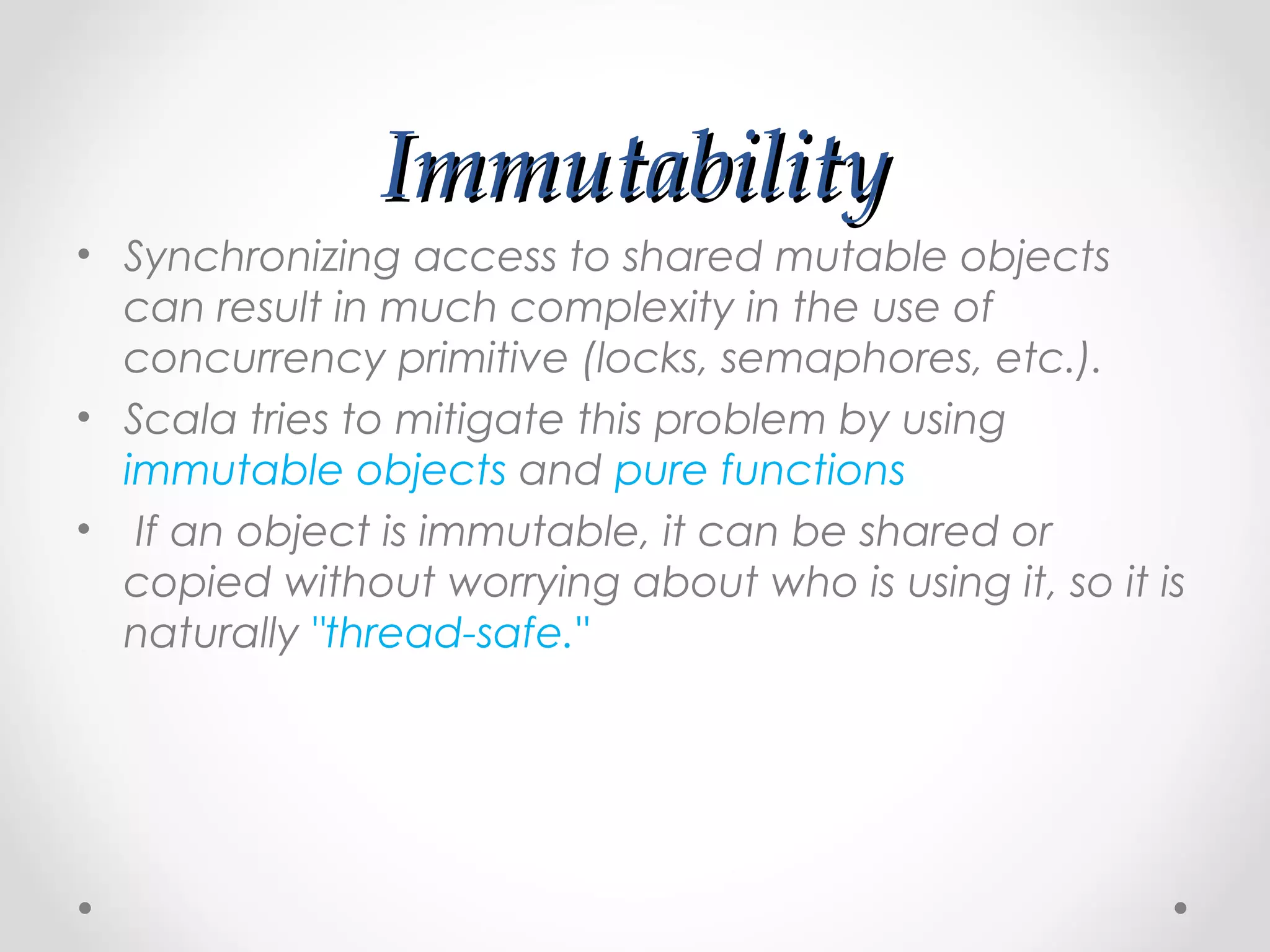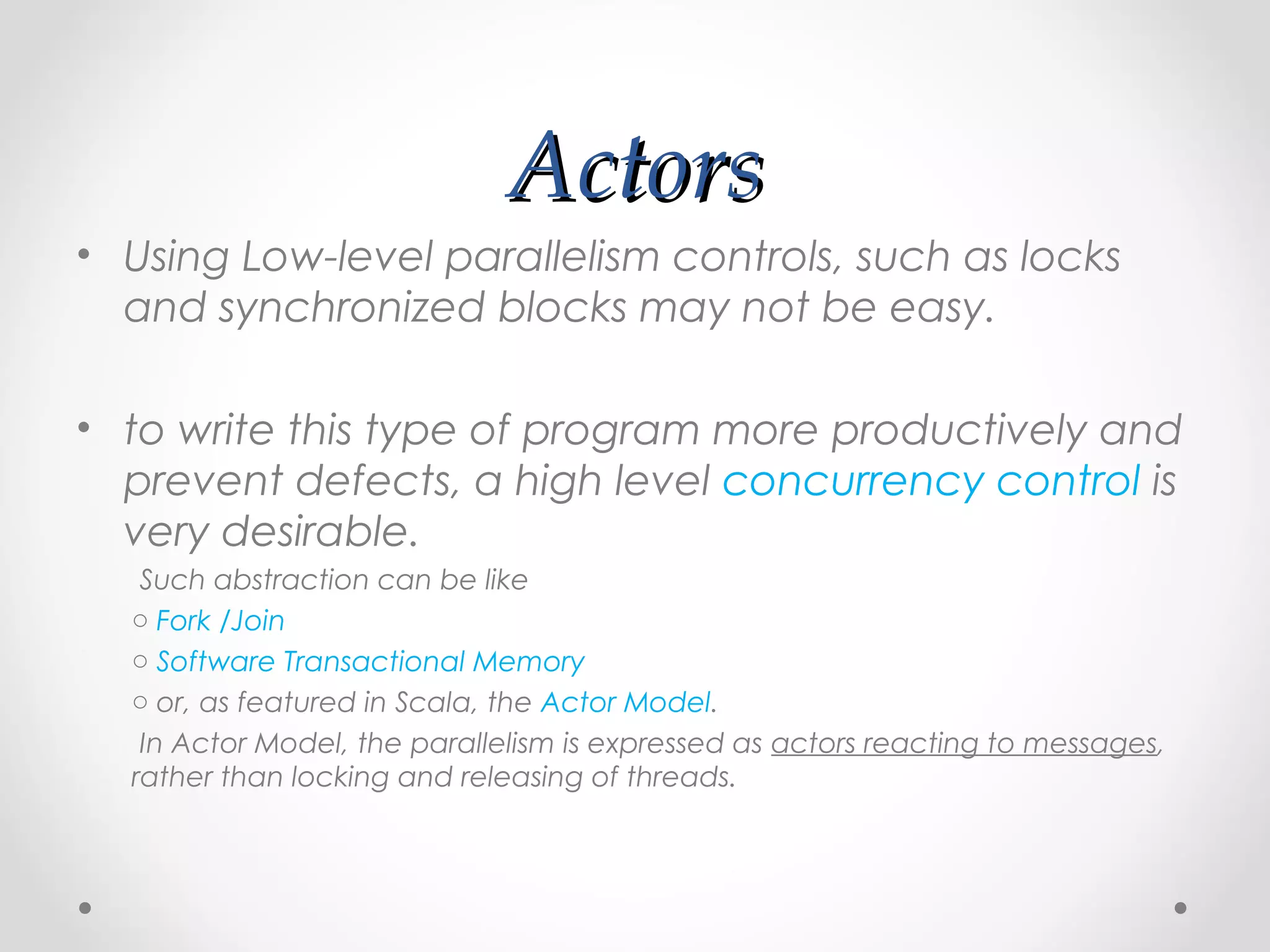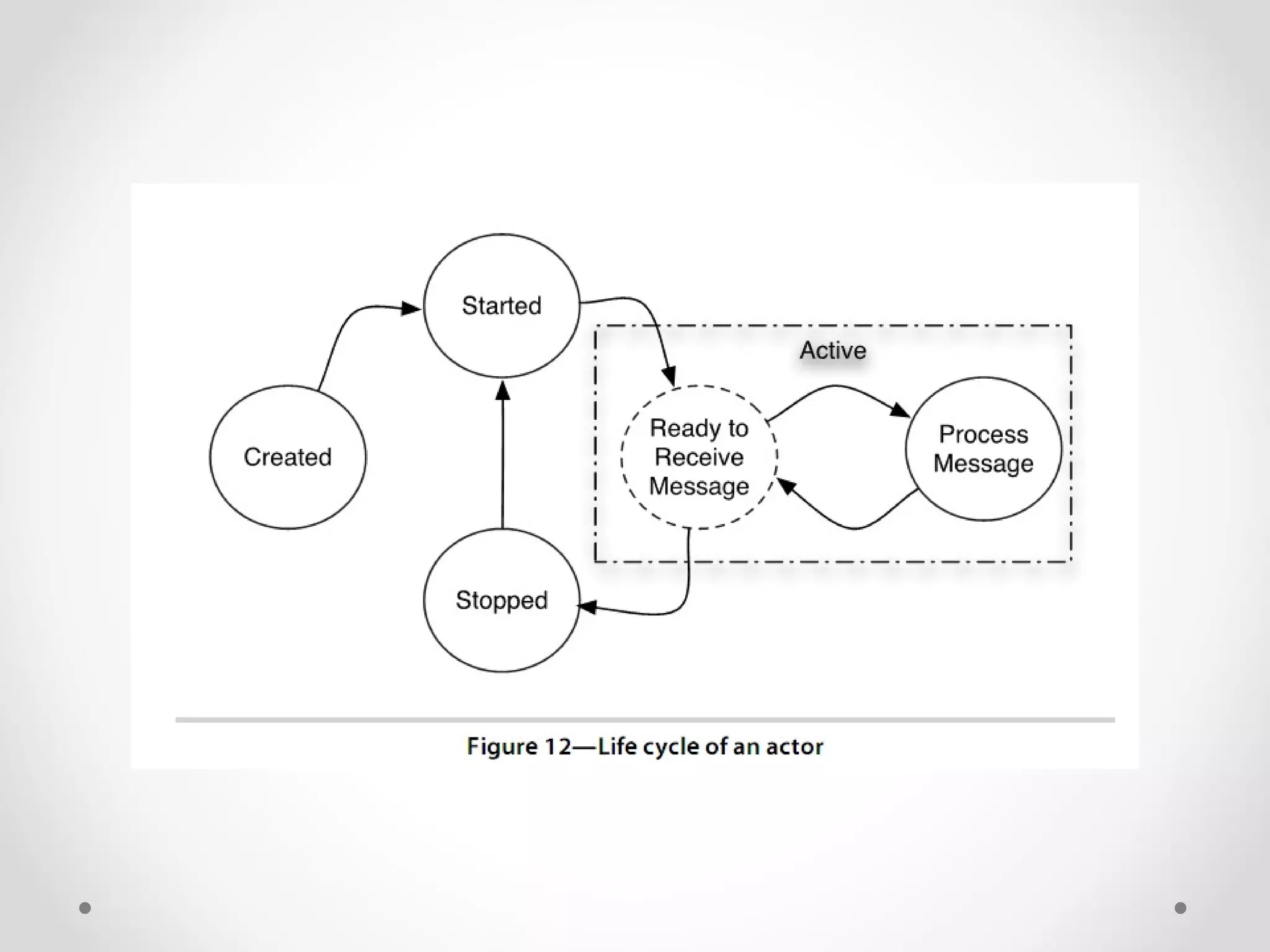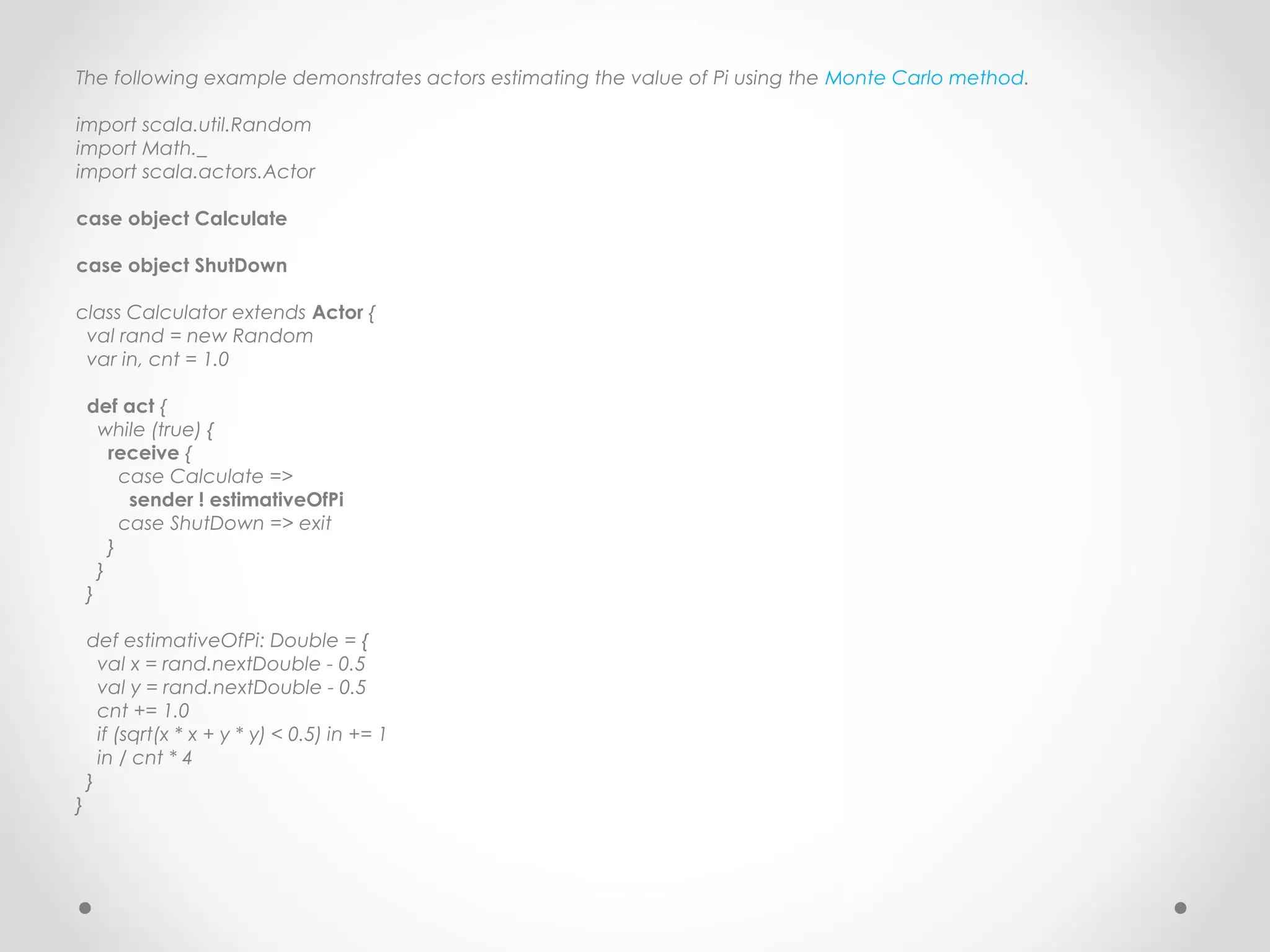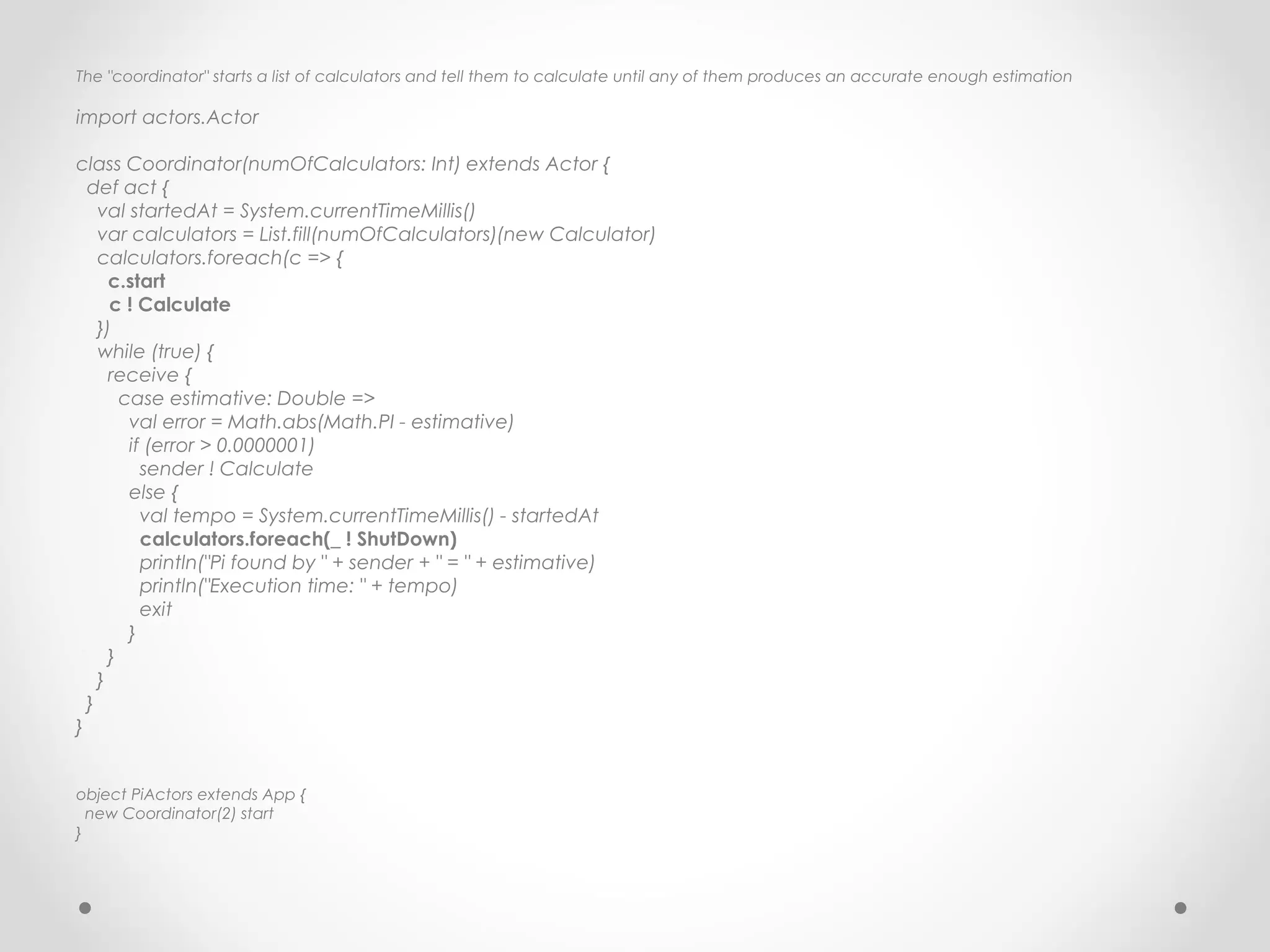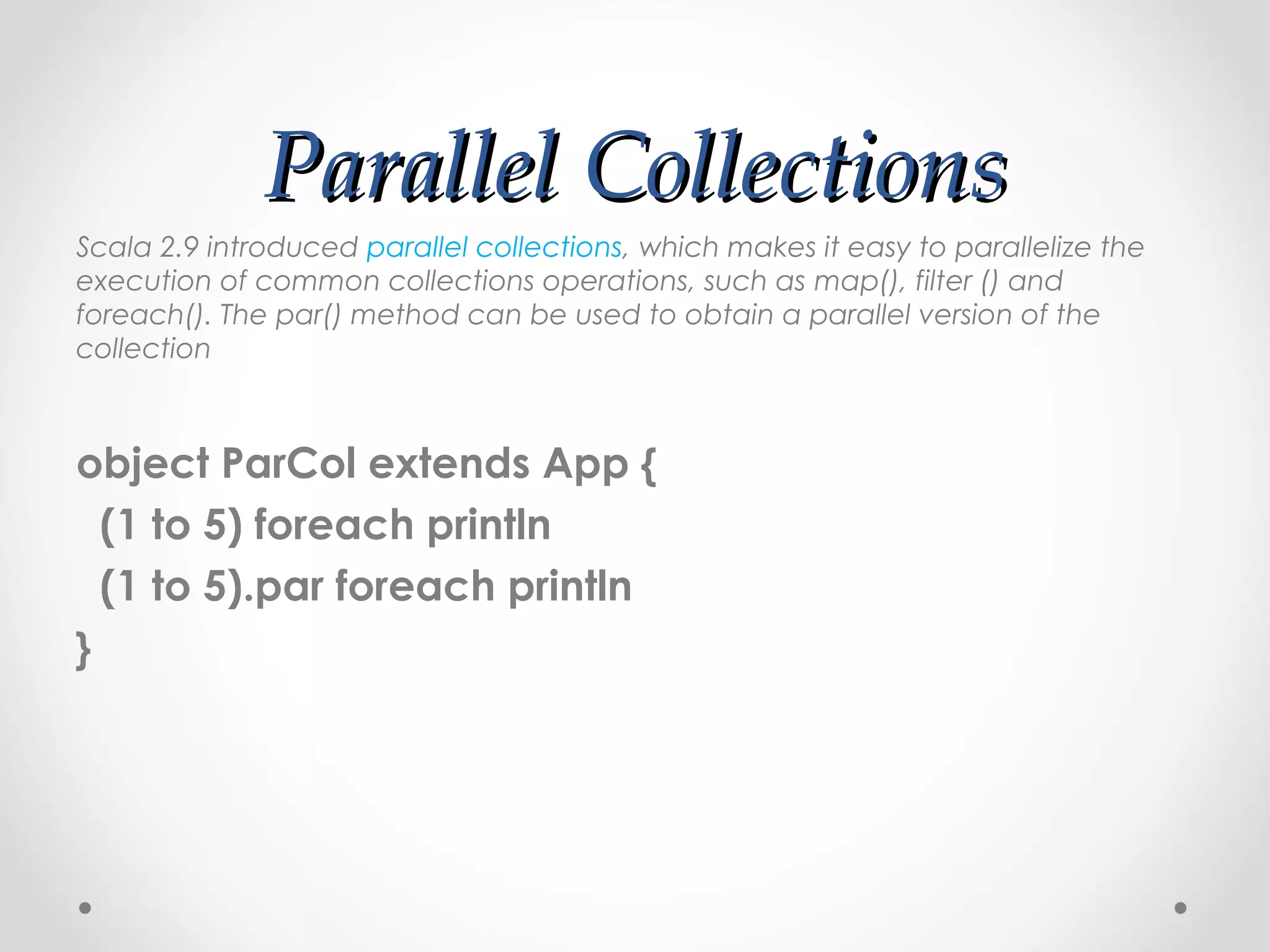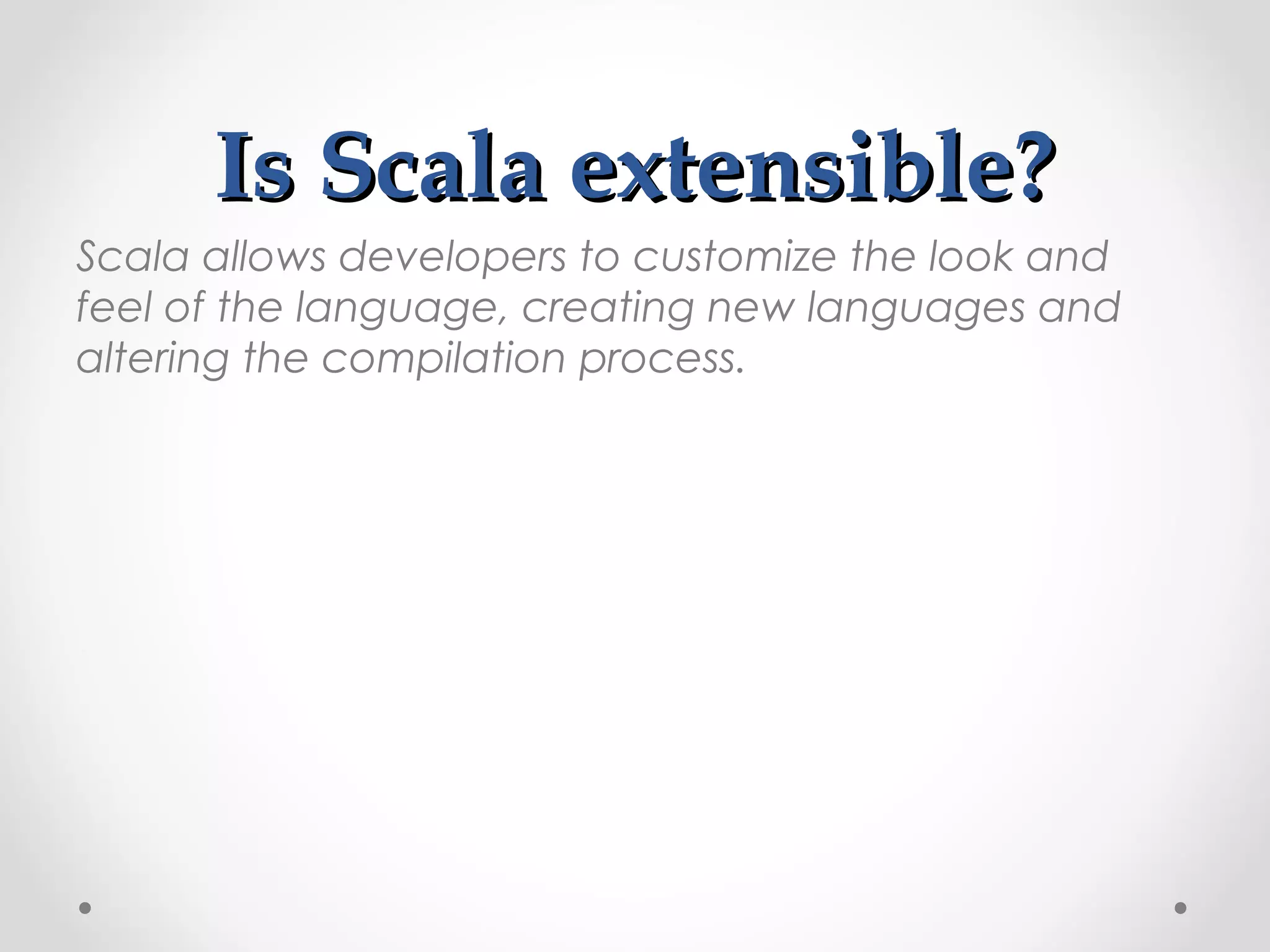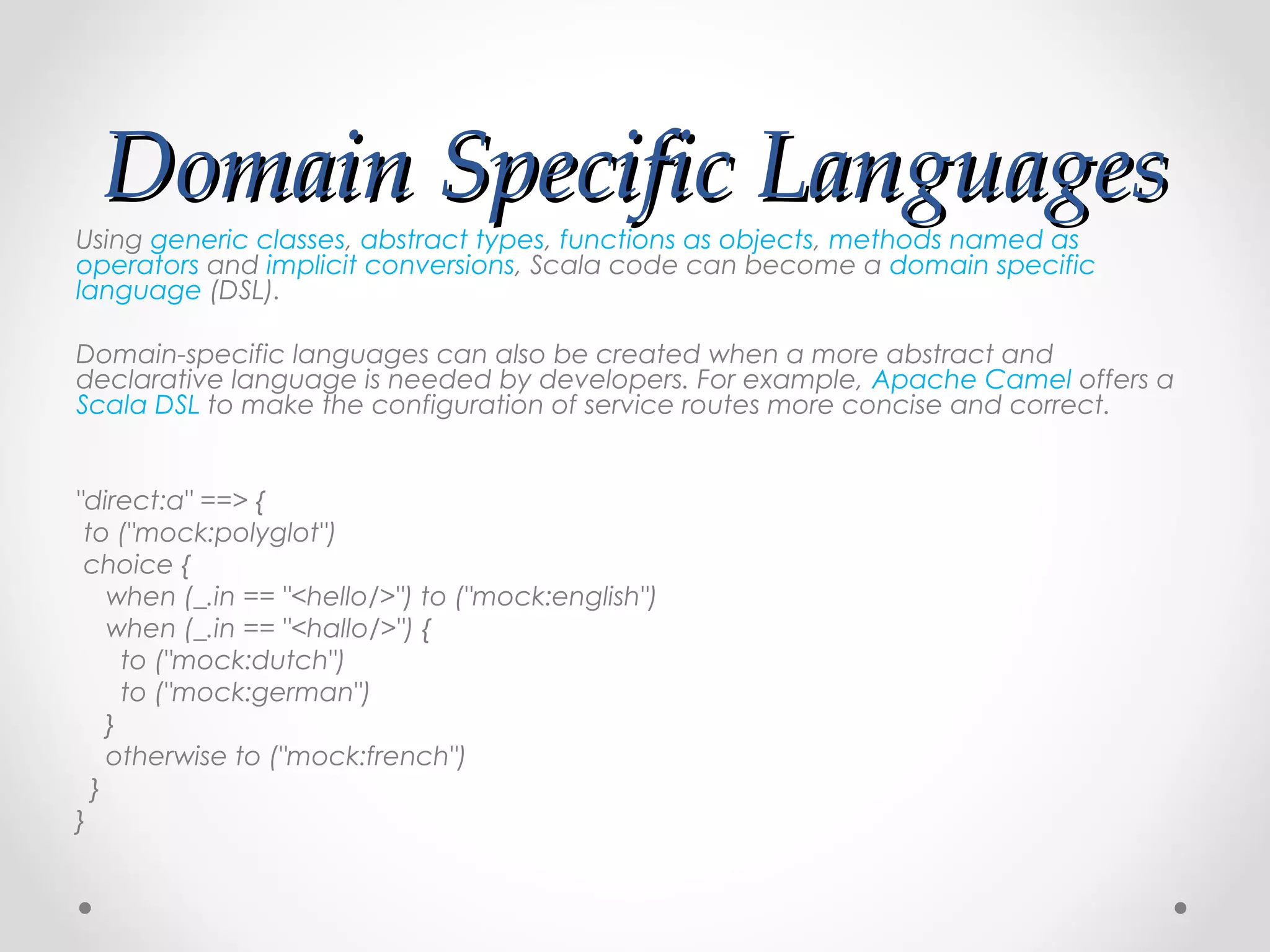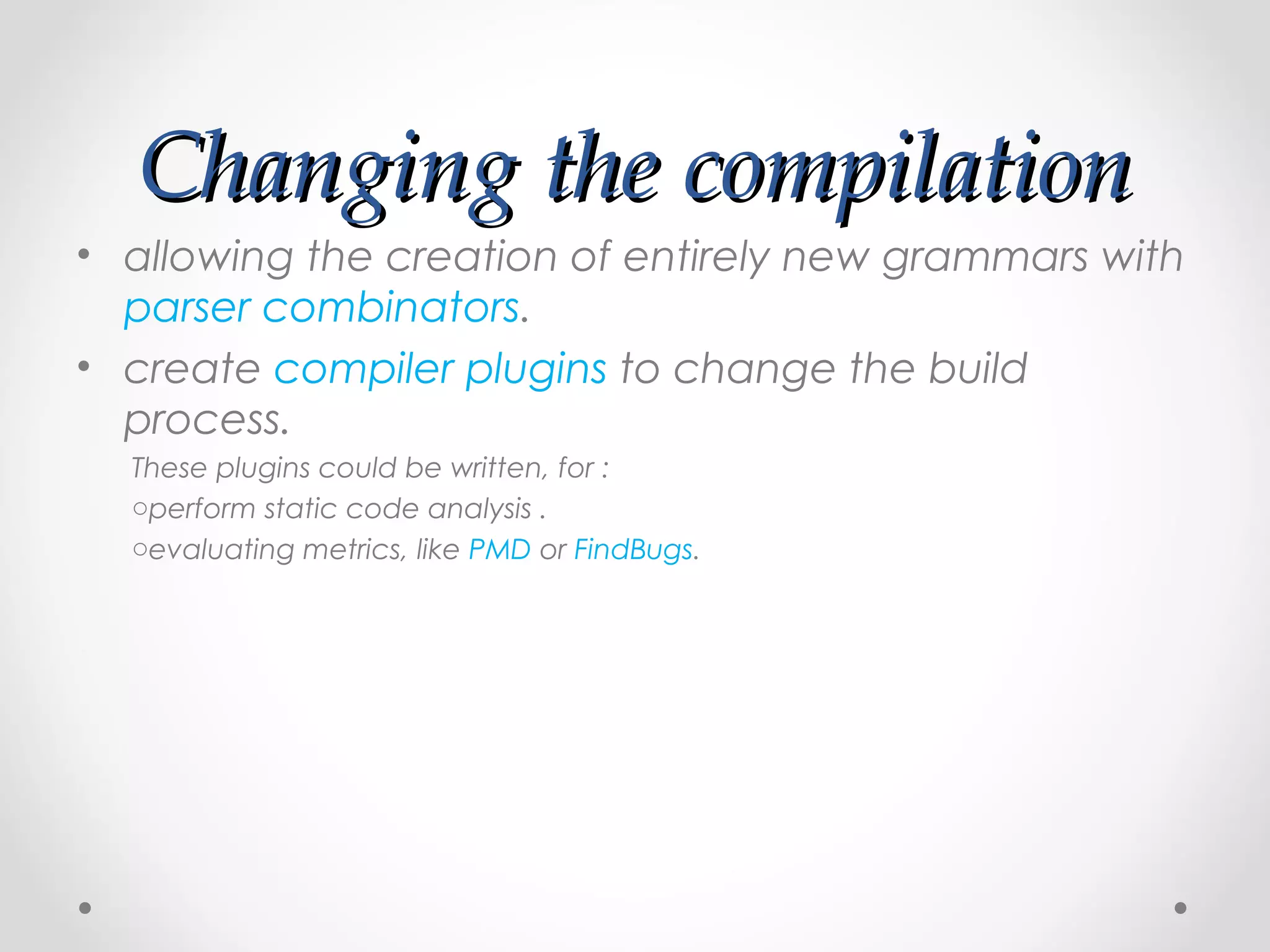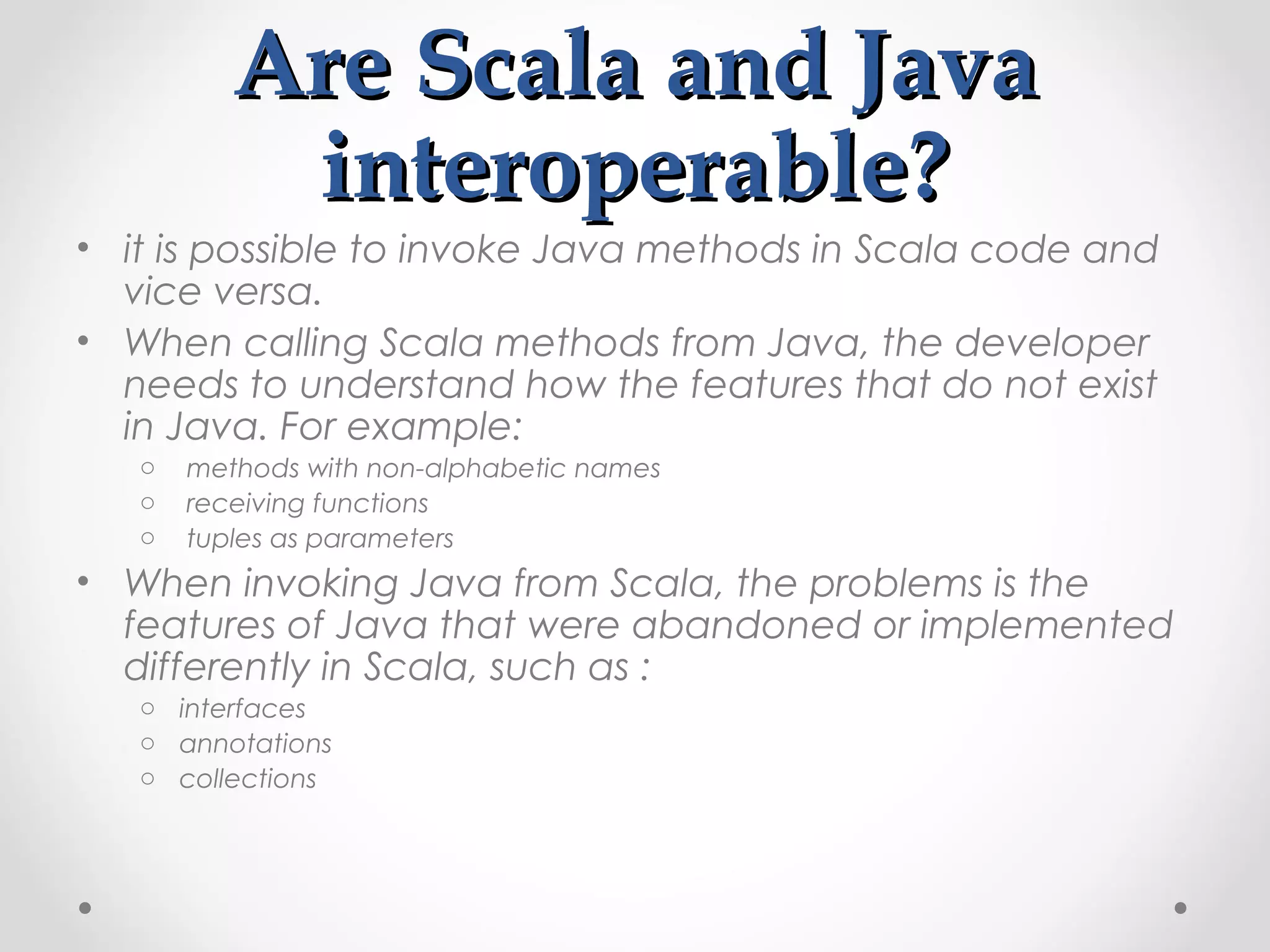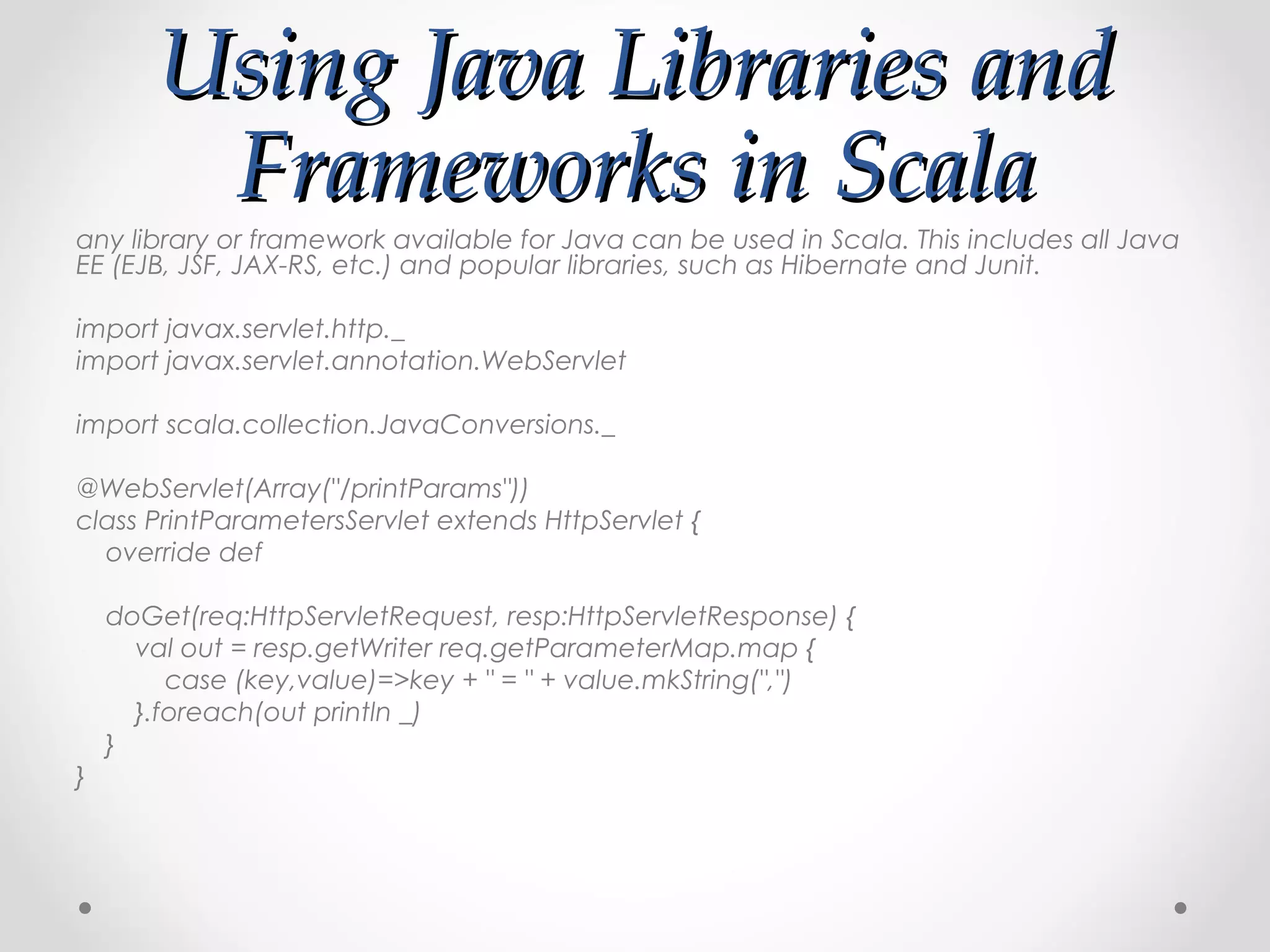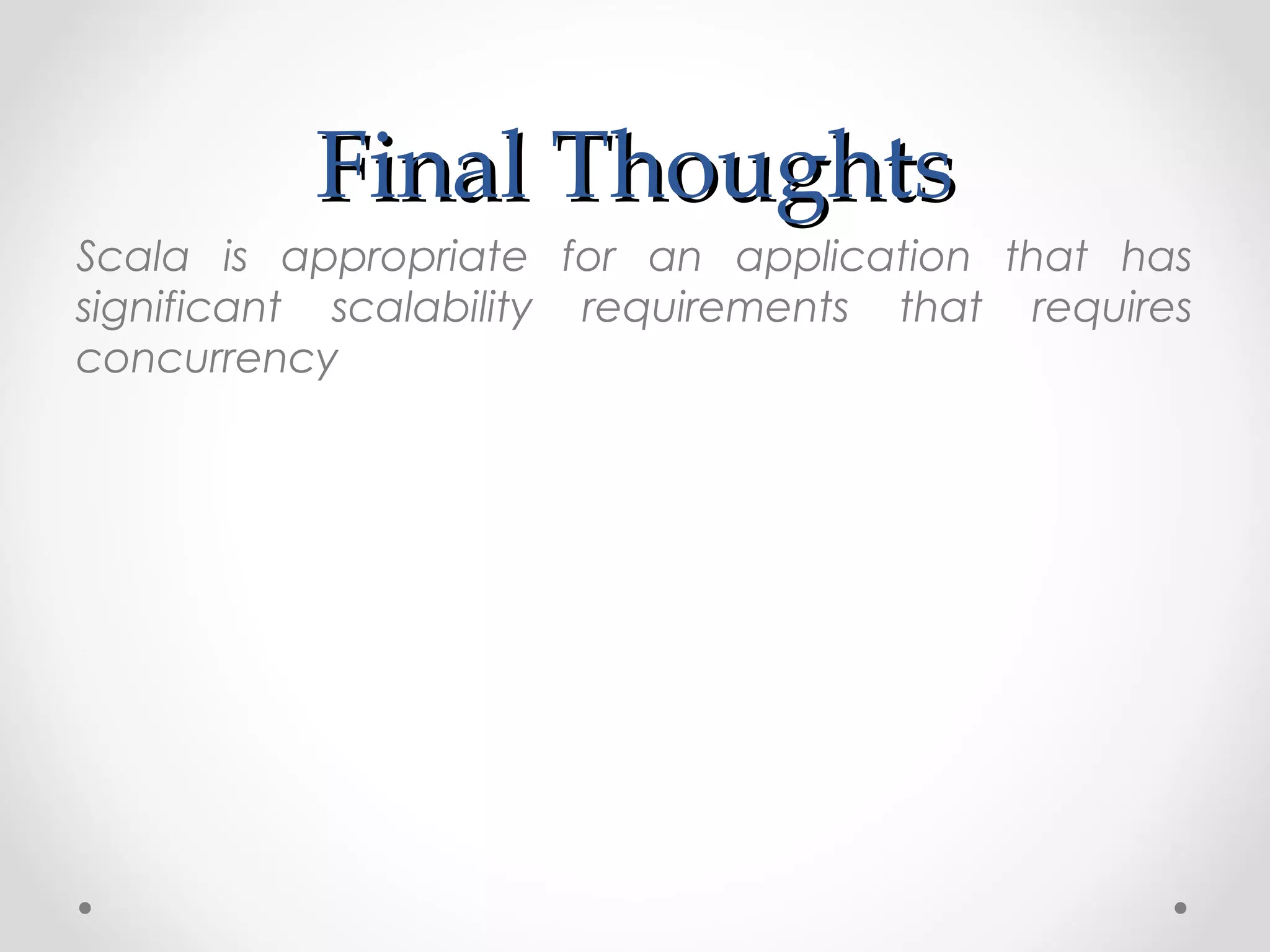Scala for Java Developers provides an overview of Scala for Java developers. It discusses:
- The goals of understanding what Scala is, learning more about it, and installing Scala.
- An introduction to Scala including what it is, its history from 1995 to 2013, and whether it is a good fit for certain uses based on its strengths like functional programming and weaknesses like syntax.
- How to get started with Scala including required and optional software and plugins.
- Key Scala features like objects, classes, traits, pattern matching, and collections.
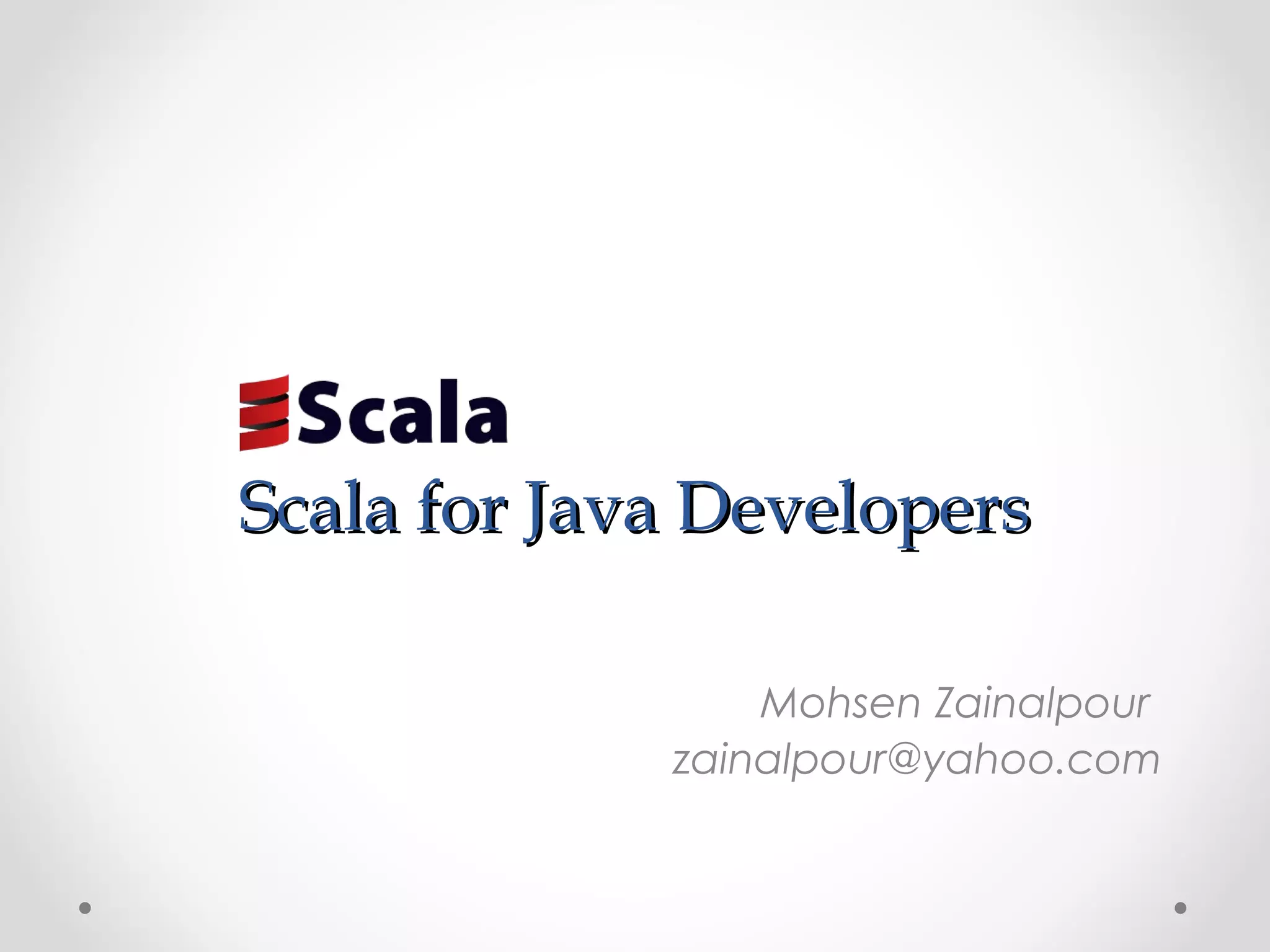
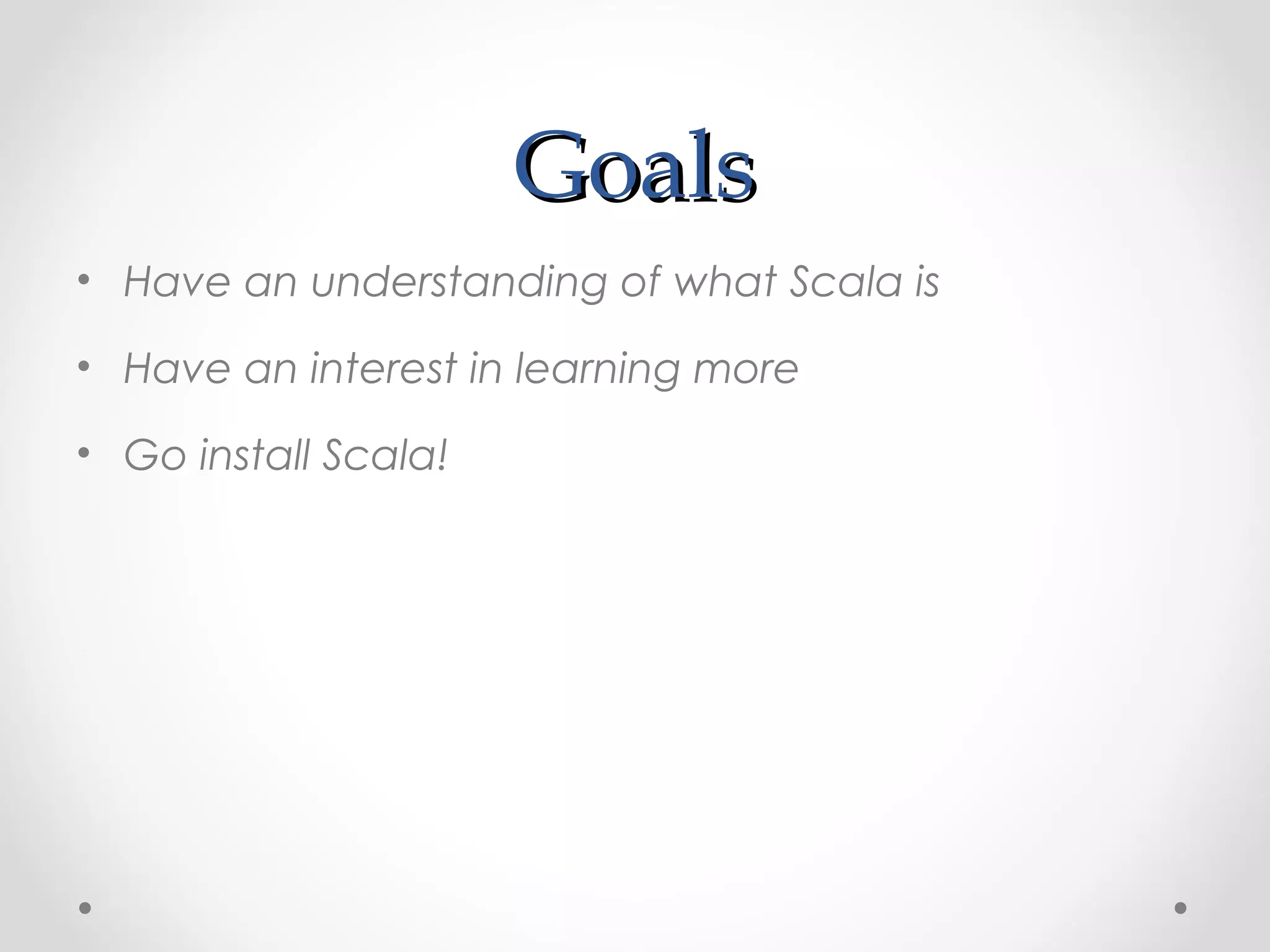
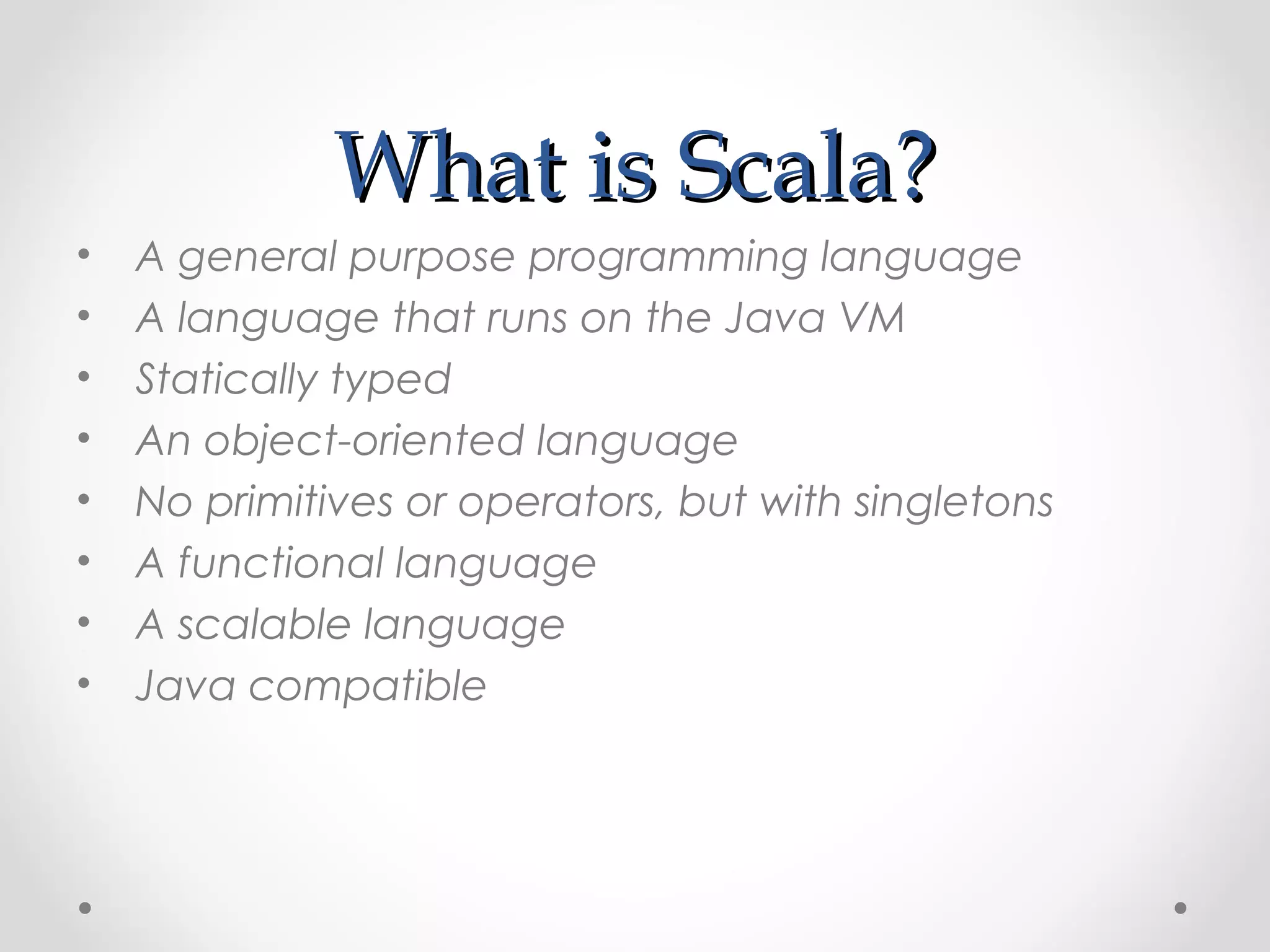
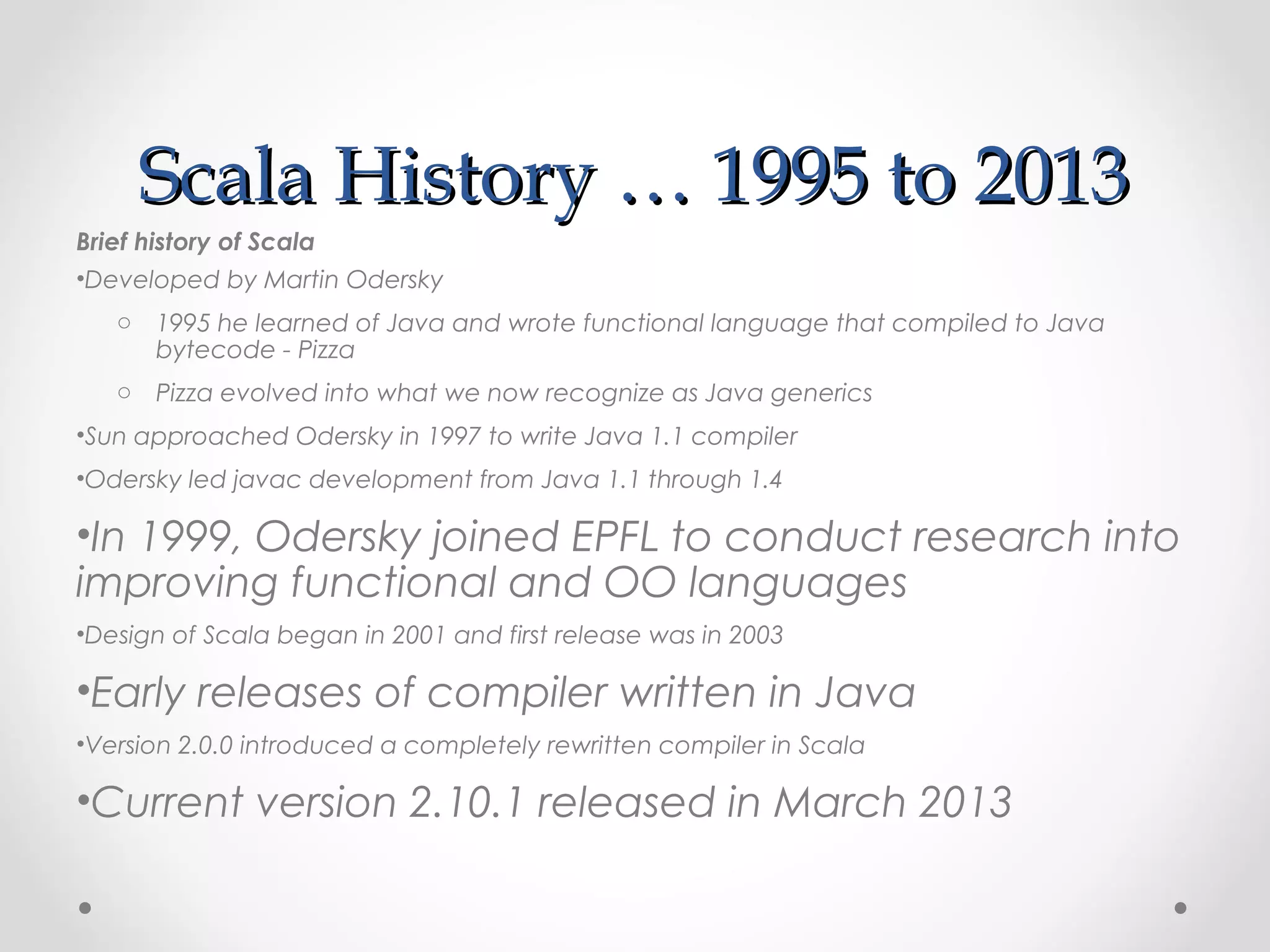
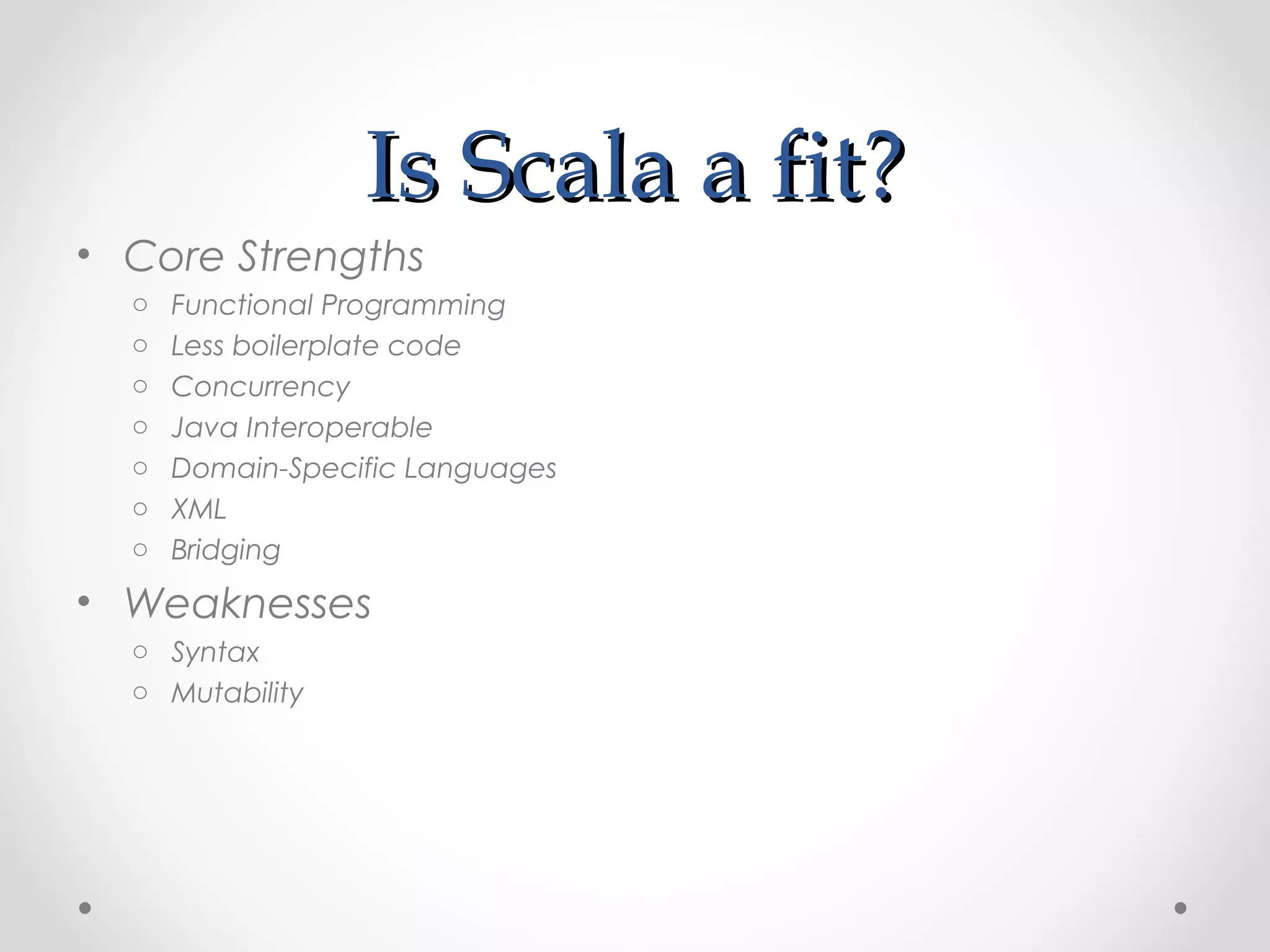
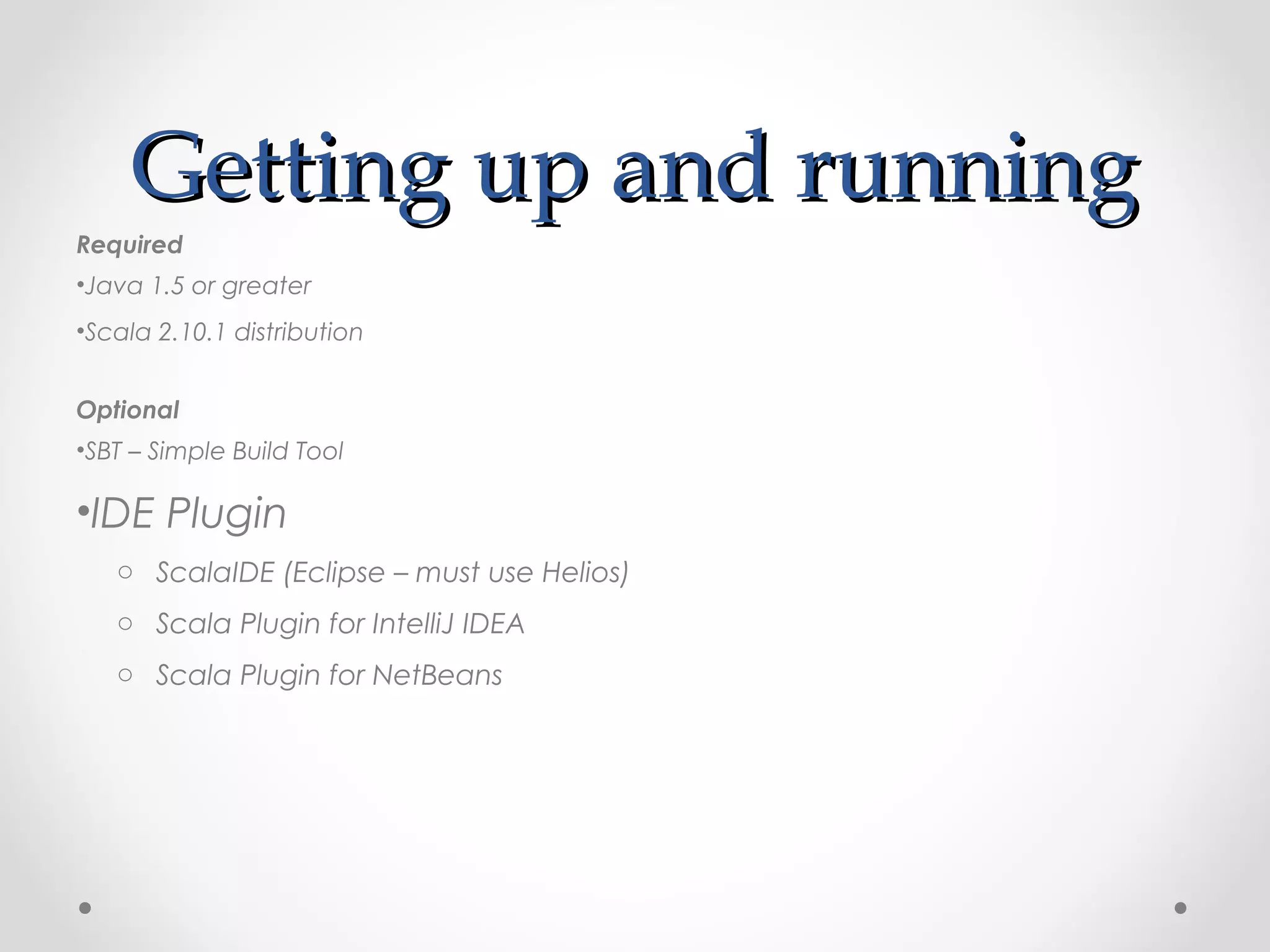
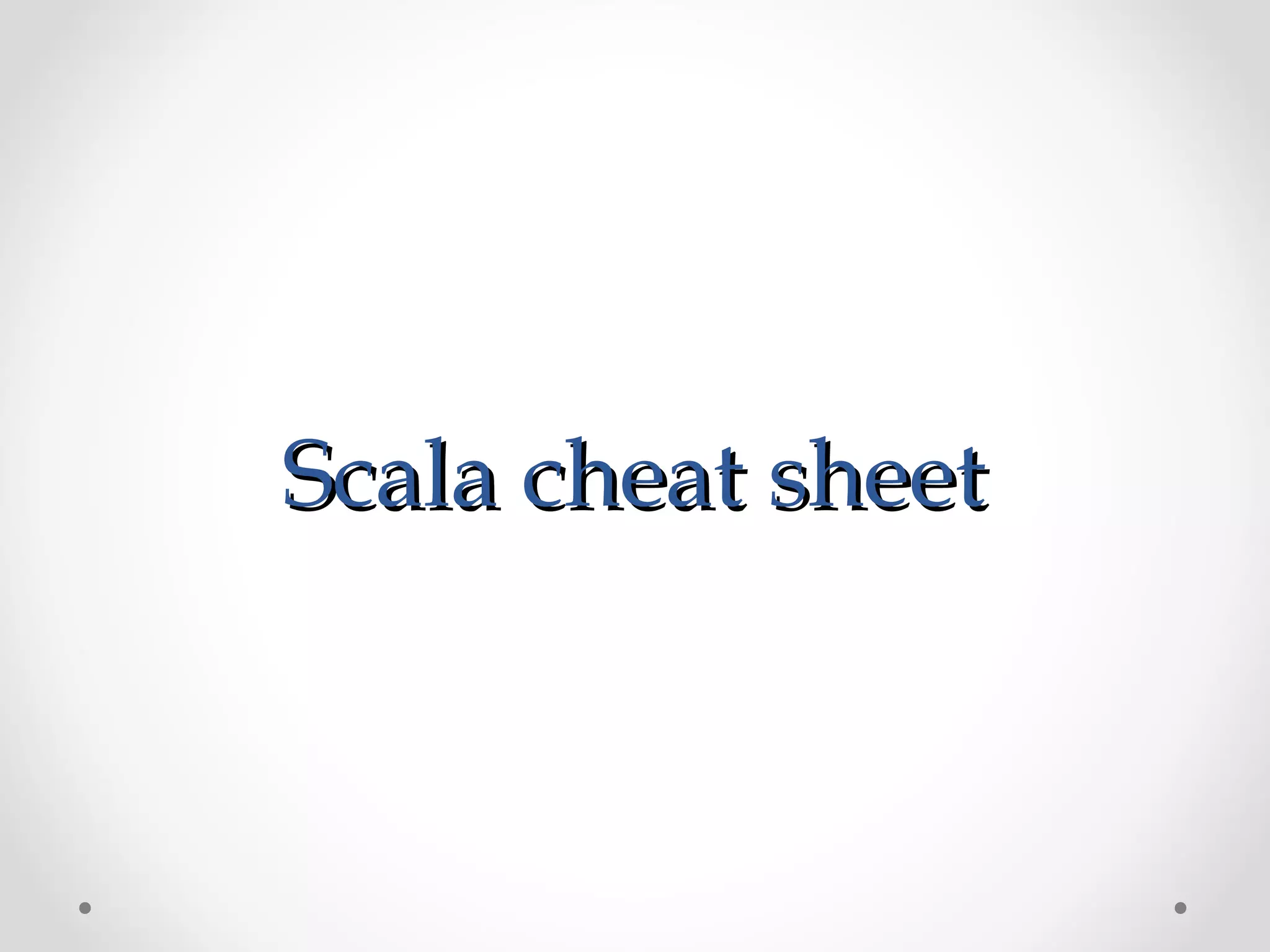
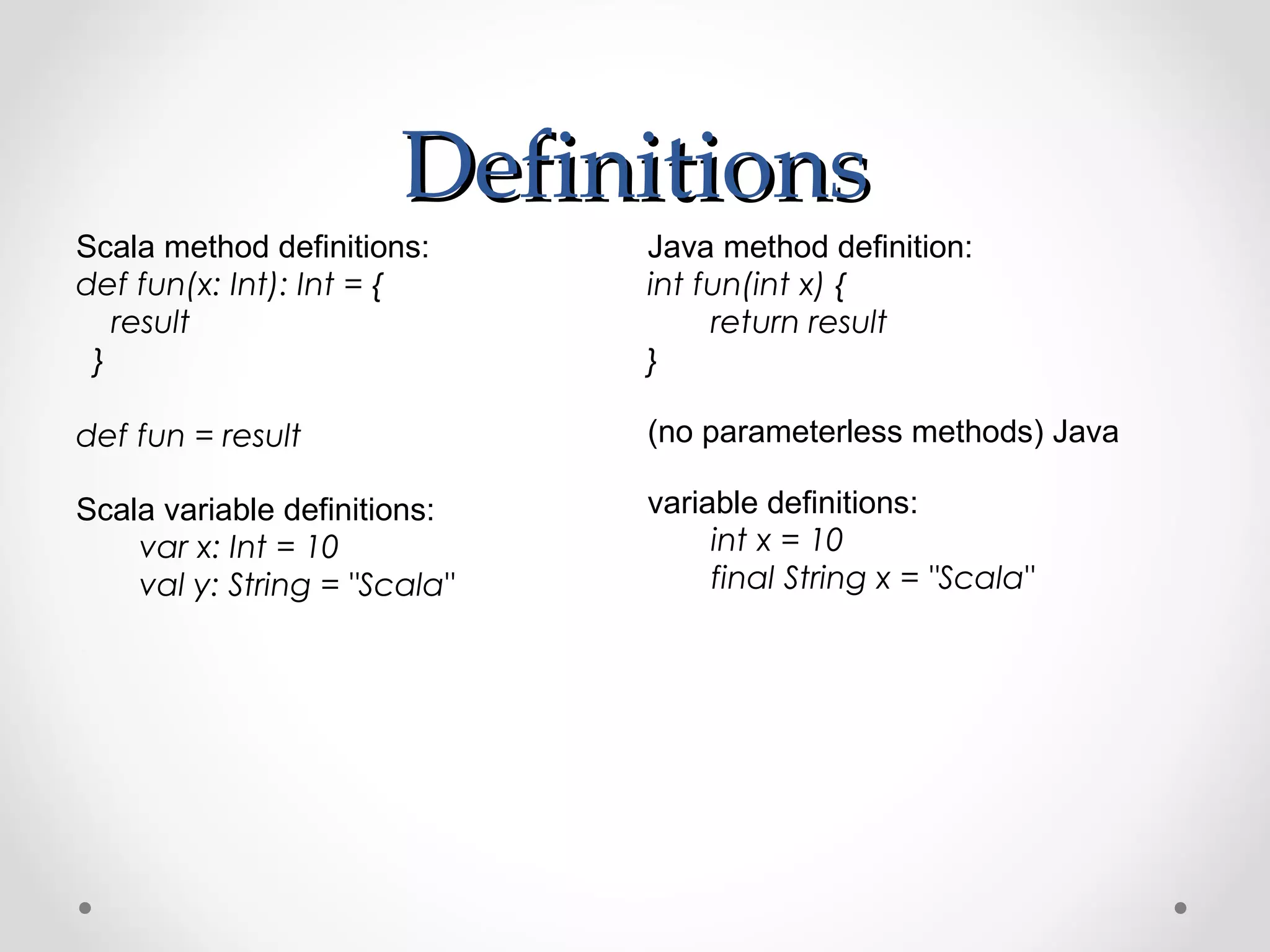
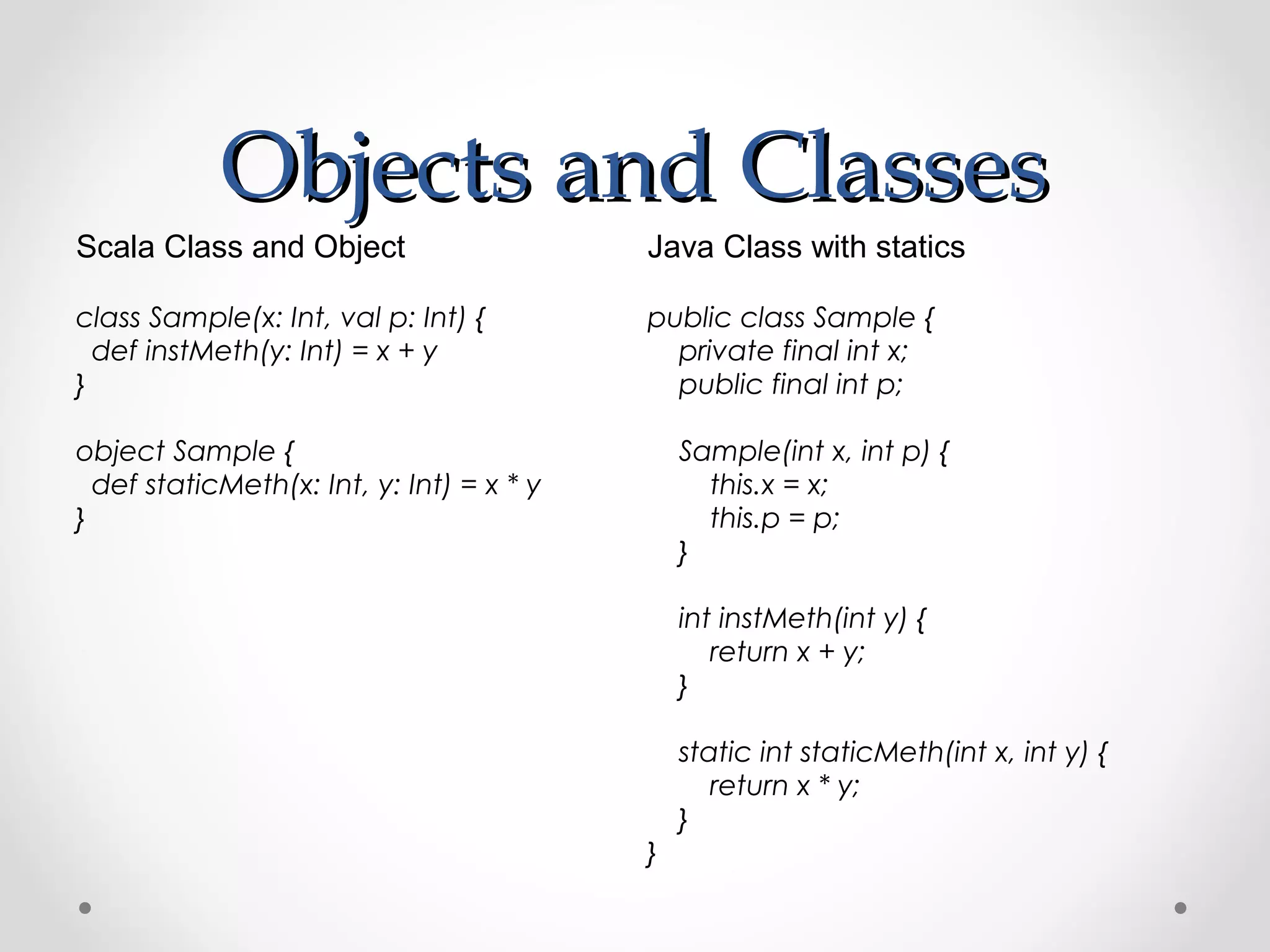
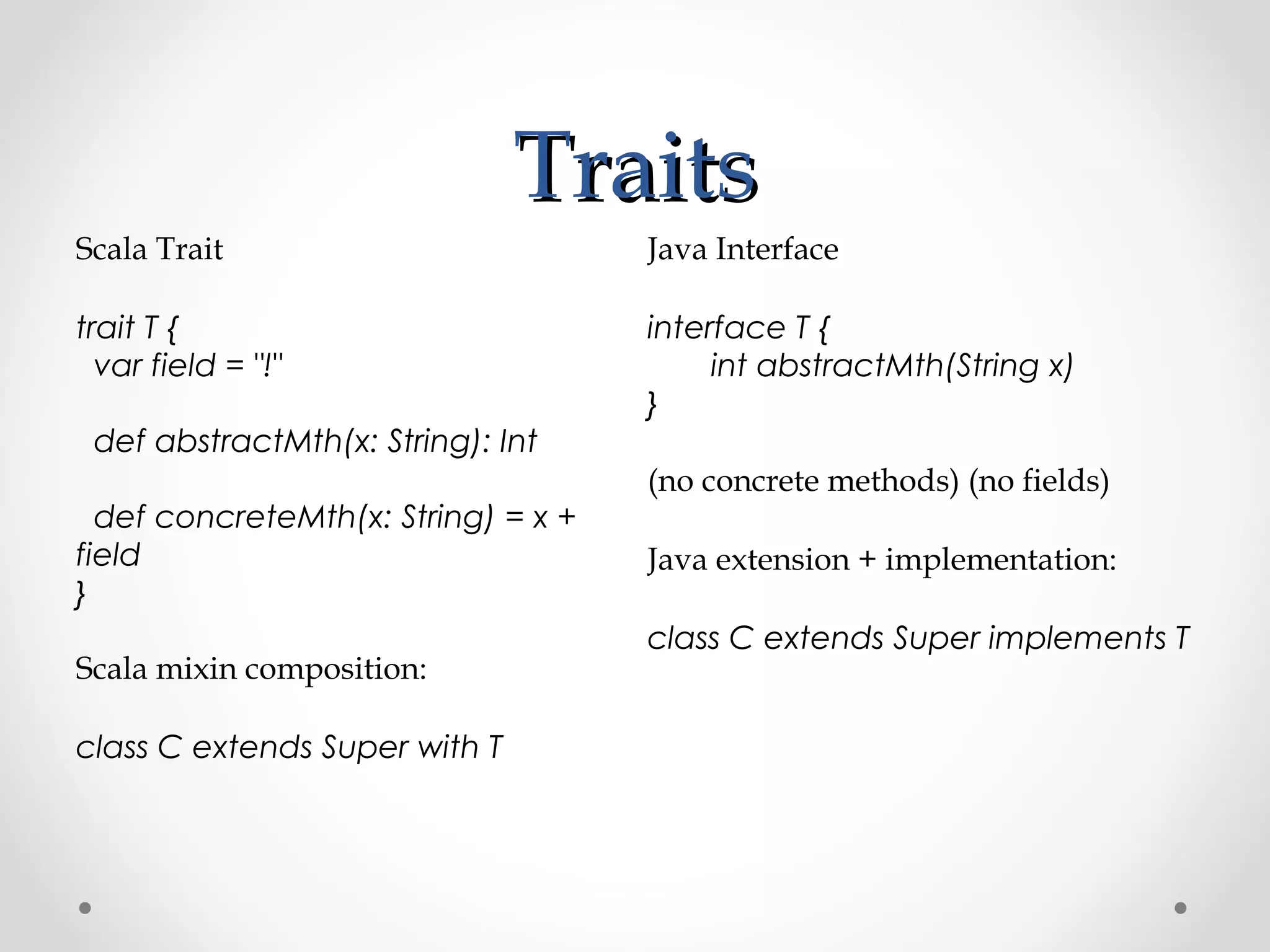
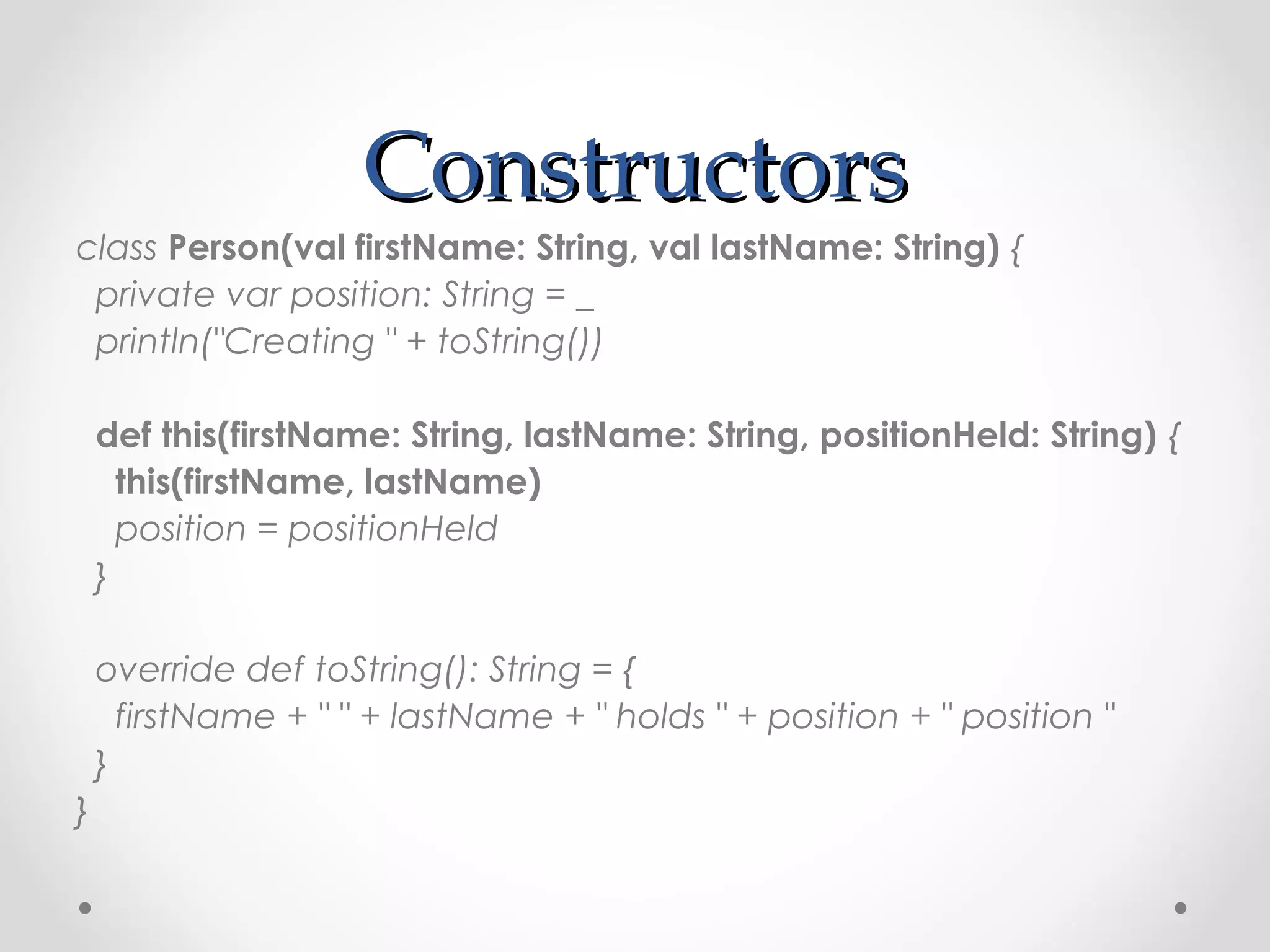
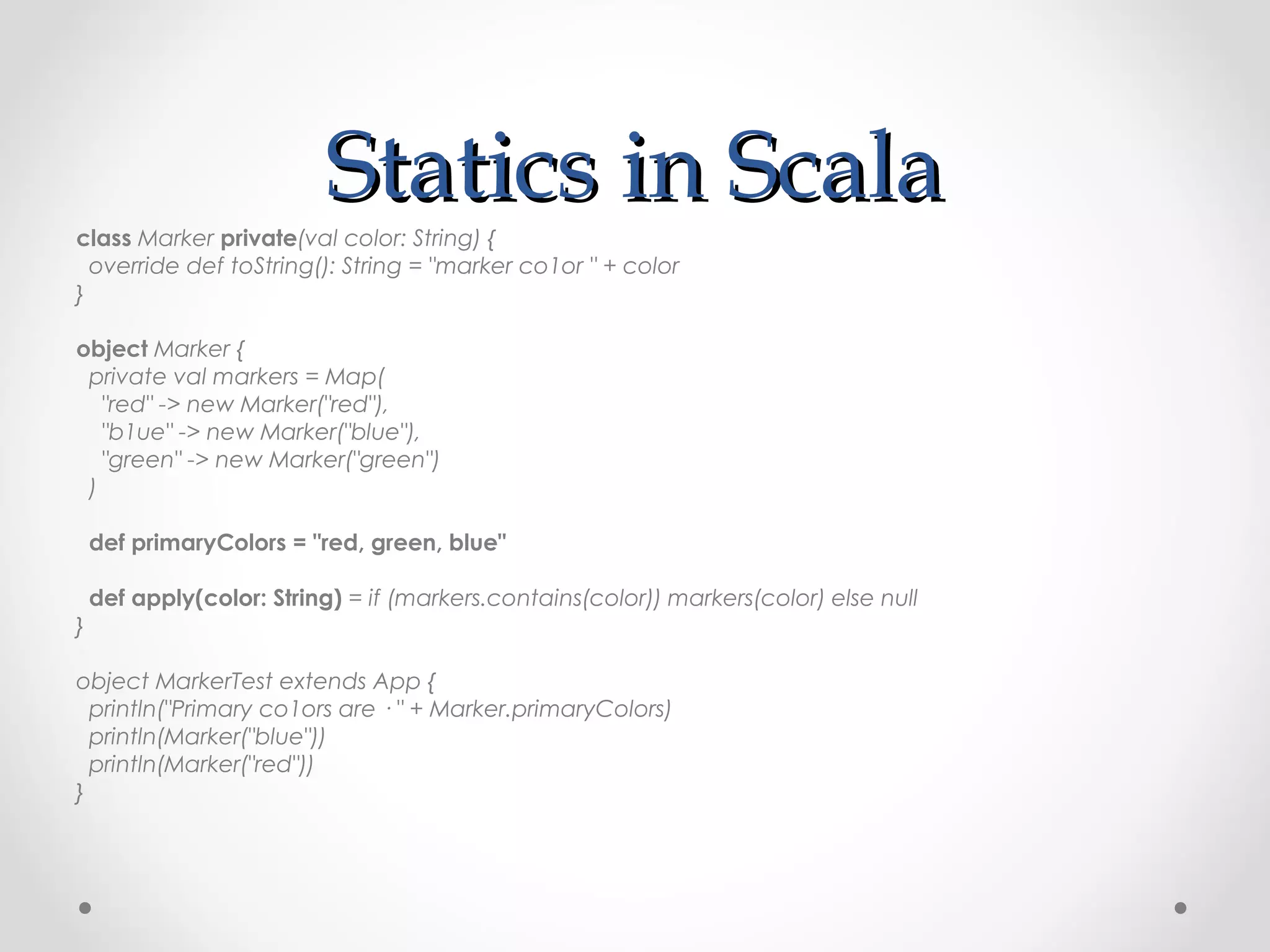
 = left + x.toString() + right
}
object FunTest extends App {
def apply(f: Int => String, v: Int) = f(v)
val decorator = new Decorator("[", "]")
println(apply(decorator.layout, 7))
}](https://image.slidesharecdn.com/anintroductiontoscala-130411234814-phpapp02/75/An-introduction-to-scala-13-2048.jpg)
![Currying & Partial
Functions
Methods may define multiple parameter lists. When a method is called with a fewer number of parameter
lists, then this will yield a function taking the missing parameter lists as its arguments.
object CurryTest extends App {
def filter(xs: List[Int], p: Int => Boolean): List[Int] =
if (xs.isEmpty) xs
else if (p(xs.head))
xs.head :: filter(xs.tail, p)
else filter(xs.tail, p)
def modN(n: Int)(x: Int) = ((x % n) == 0)
val nums = List(1, 2, 3, 4, 5, 6, 7, 8)
println(filter(nums, modN(2)))
println(filter(nums, modN(3)))
}](https://image.slidesharecdn.com/anintroductiontoscala-130411234814-phpapp02/75/An-introduction-to-scala-14-2048.jpg)
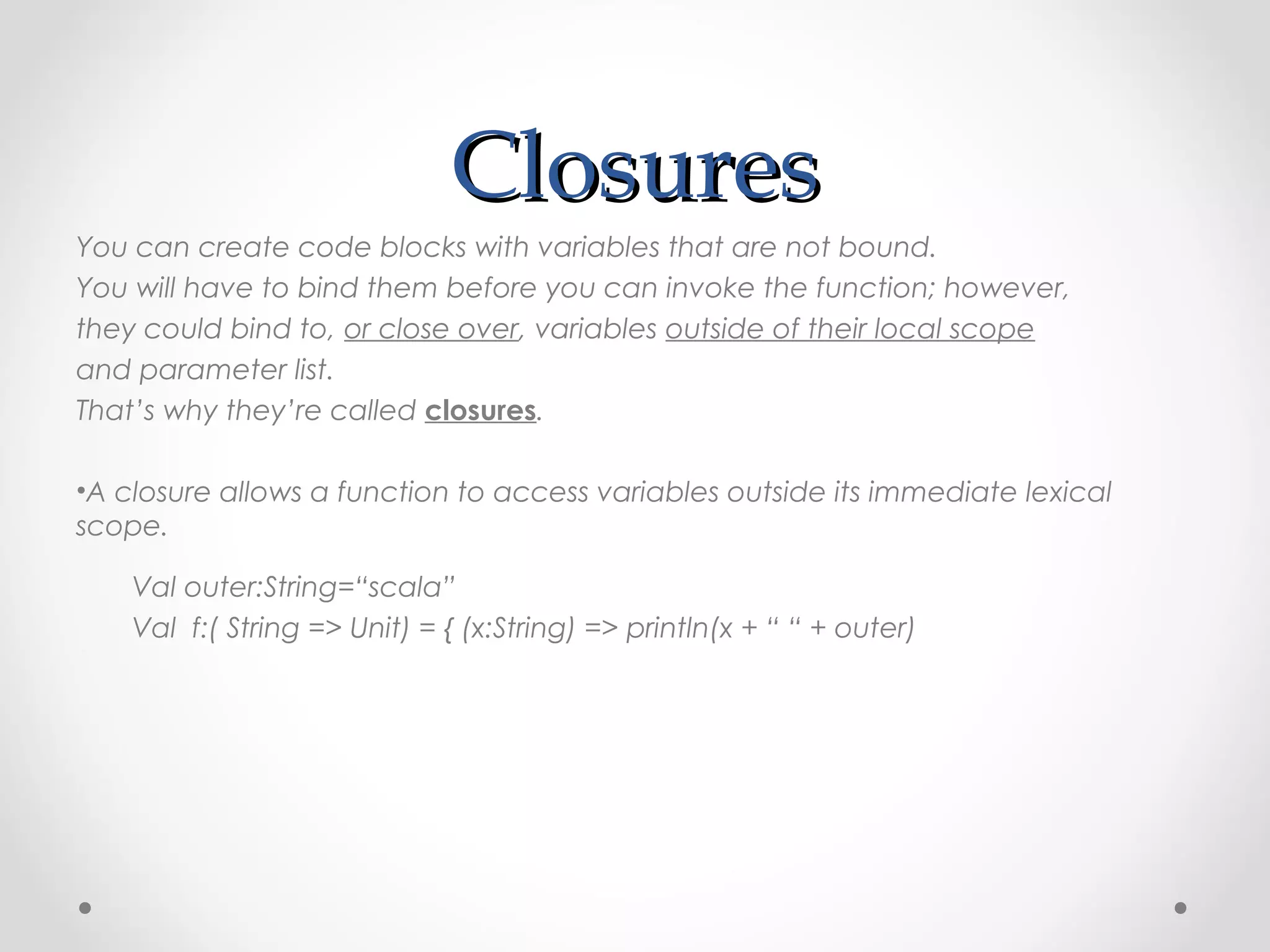
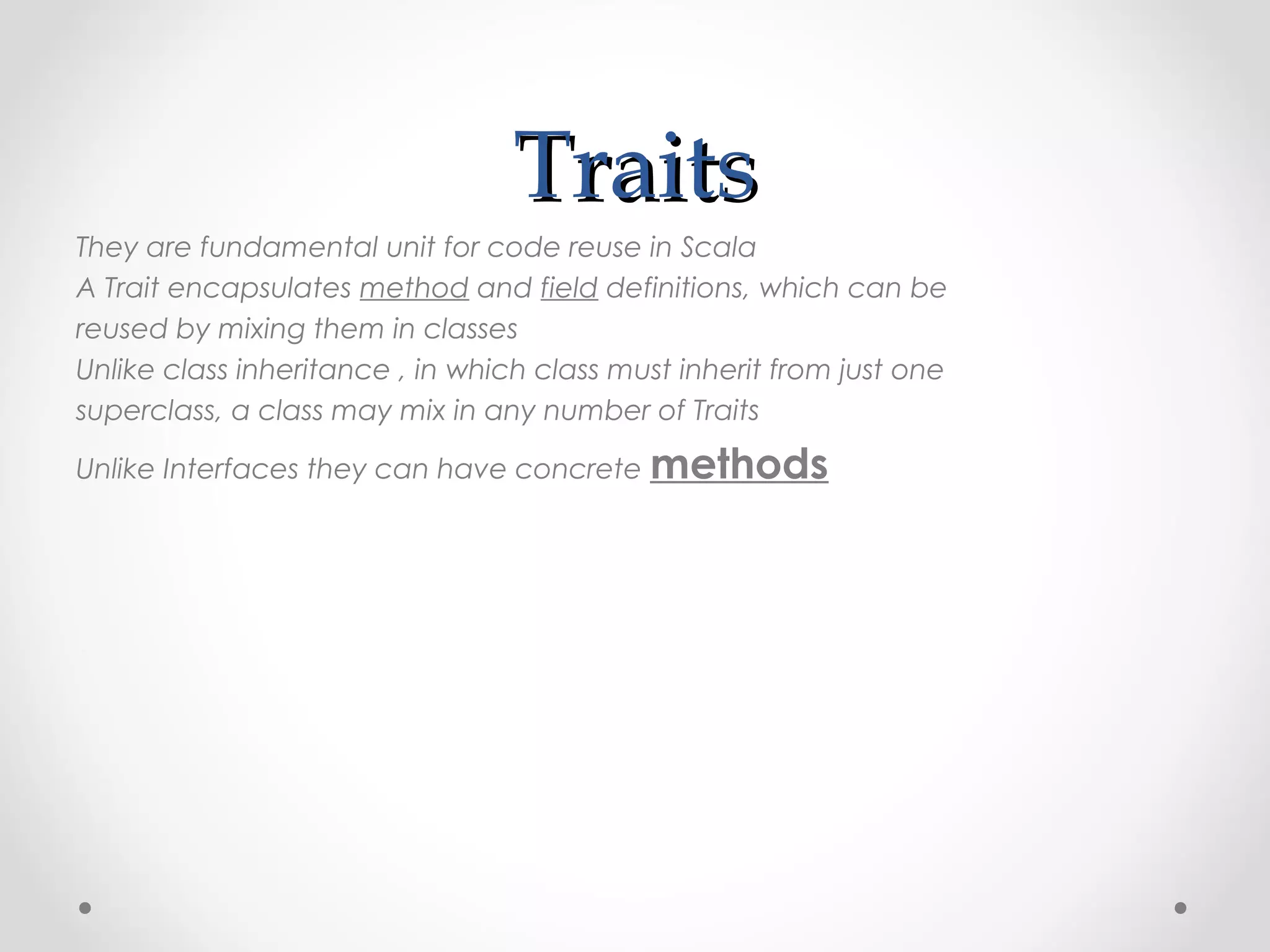
![import scala.collection.mutable.ArrayBuffer //Mixing traits in type definition
class DoublePlusOneQueue extends IntQueueImpl with
//Type Definition Incrementing with Doubling
abstract class IntQueue {
def get(): Int object QueueWithTraits {
def main(args: Array[String]) {
def put(x: Int) val queue1 = new DoublePlusOneQueue
queue1 put 1
def size(): Int queue1 put 2
} println(queue1 get)
println(queue1 get)
//ArrayBuffer implementation
class IntQueueImpl extends IntQueue { //Mixing traits in object instantiation
private val buf = new ArrayBuffer[Int] val queue2 = new IntQueueImpl with Filtering
queue2 put -1
def get = buf remove 0 queue2 put 1
println(queue2 size)
def put(x: Int) { }
buf += x }
}
def size = buf length
}
trait Doubling extends IntQueue {
abstract override def put(x: Int) {
super.put(2 * x)
}
}
trait Incrementing extends IntQueue {
abstract override def put(x: Int) {
super.put(x + 1)
}
}
trait Filtering extends IntQueue {
abstract override def put(x: Int) {
if (x > 0) super.put(x)
}
}](https://image.slidesharecdn.com/anintroductiontoscala-130411234814-phpapp02/75/An-introduction-to-scala-17-2048.jpg)
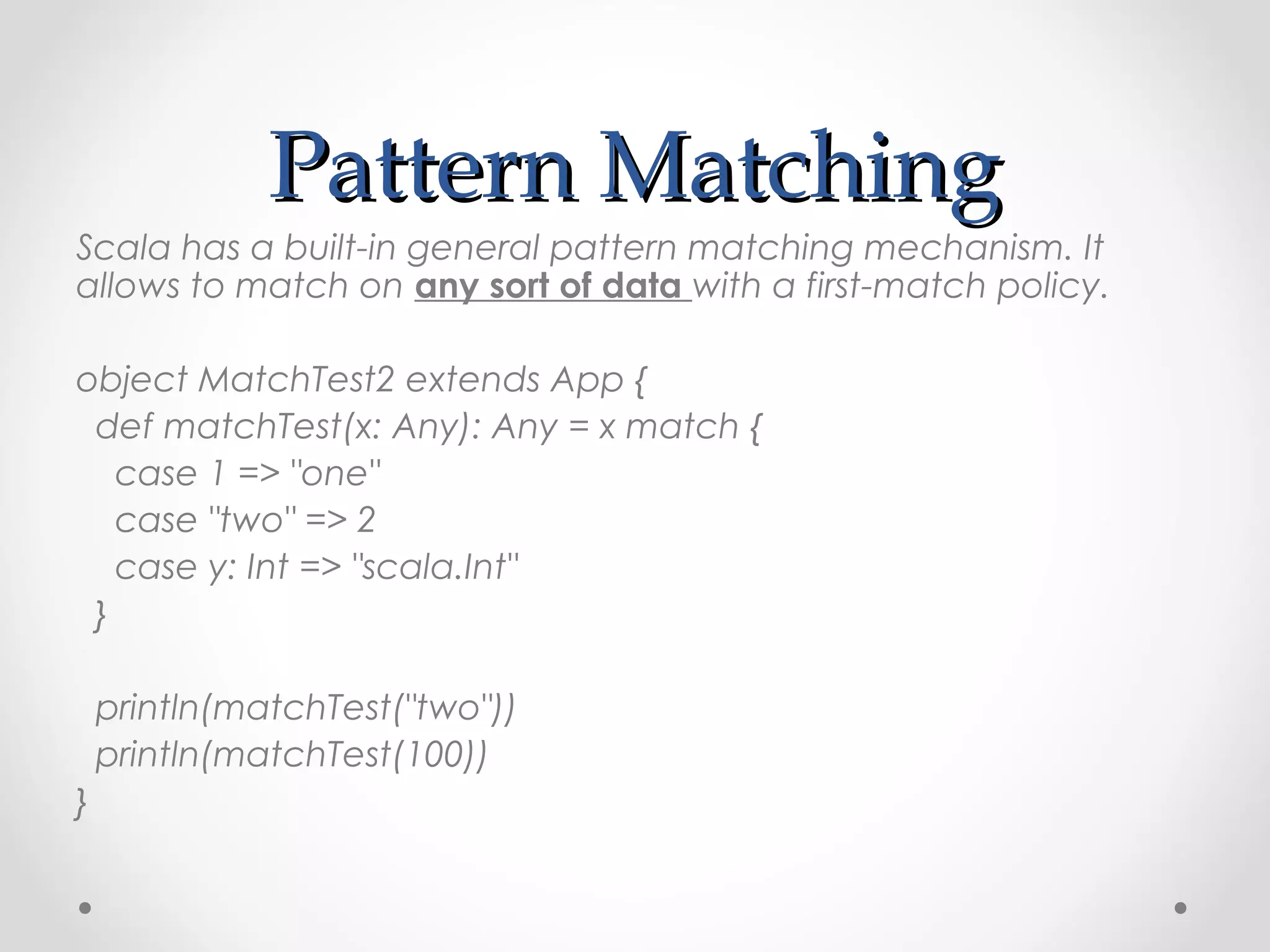
![Collections
Basic Data Structures
•Lists
val numbers = List(1, 2, 3, 4)
•Sets
Set(1, 1, 2)
•Tuple
val hostPort = ("localhost", 80)
•Maps
Map(1 -> 2)
Functional Combinators
•Map
scala> numbers.map((i: Int) => i * 2)
res0: List[Int] = List(2, 4, 6, 8)
•Foreach
numbers.foreach((i: Int) => i * 2)](https://image.slidesharecdn.com/anintroductiontoscala-130411234814-phpapp02/75/An-introduction-to-scala-19-2048.jpg)
![Collections
• Filter
scala> numbers.filter((i: Int) => i % 2 == 0)
res0: List[Int] = List(2, 4)
• Zip
scala> List(1, 2, 3).zip(List("a", "b", "c"))
res0: List[(Int, String)] = List((1,a), (2,b), (3,c))
• Partition
scala> val numbers = List(1, 2, 3, 4, 5, 6, 7, 8, 9, 10)
scala> numbers.partition(_ %2 == 0)
res0: (List[Int], List[Int]) = (List(2, 4, 6, 8, 10),List(1, 3, 5, 7, 9))
• Find
scala> numbers.find((i: Int) => i > 5)
res0: Option[Int] = Some(6)
• drop and dropWhile
scala> numbers.drop(5)
res0: List[Int] = List(6, 7, 8, 9, 10)](https://image.slidesharecdn.com/anintroductiontoscala-130411234814-phpapp02/75/An-introduction-to-scala-20-2048.jpg)
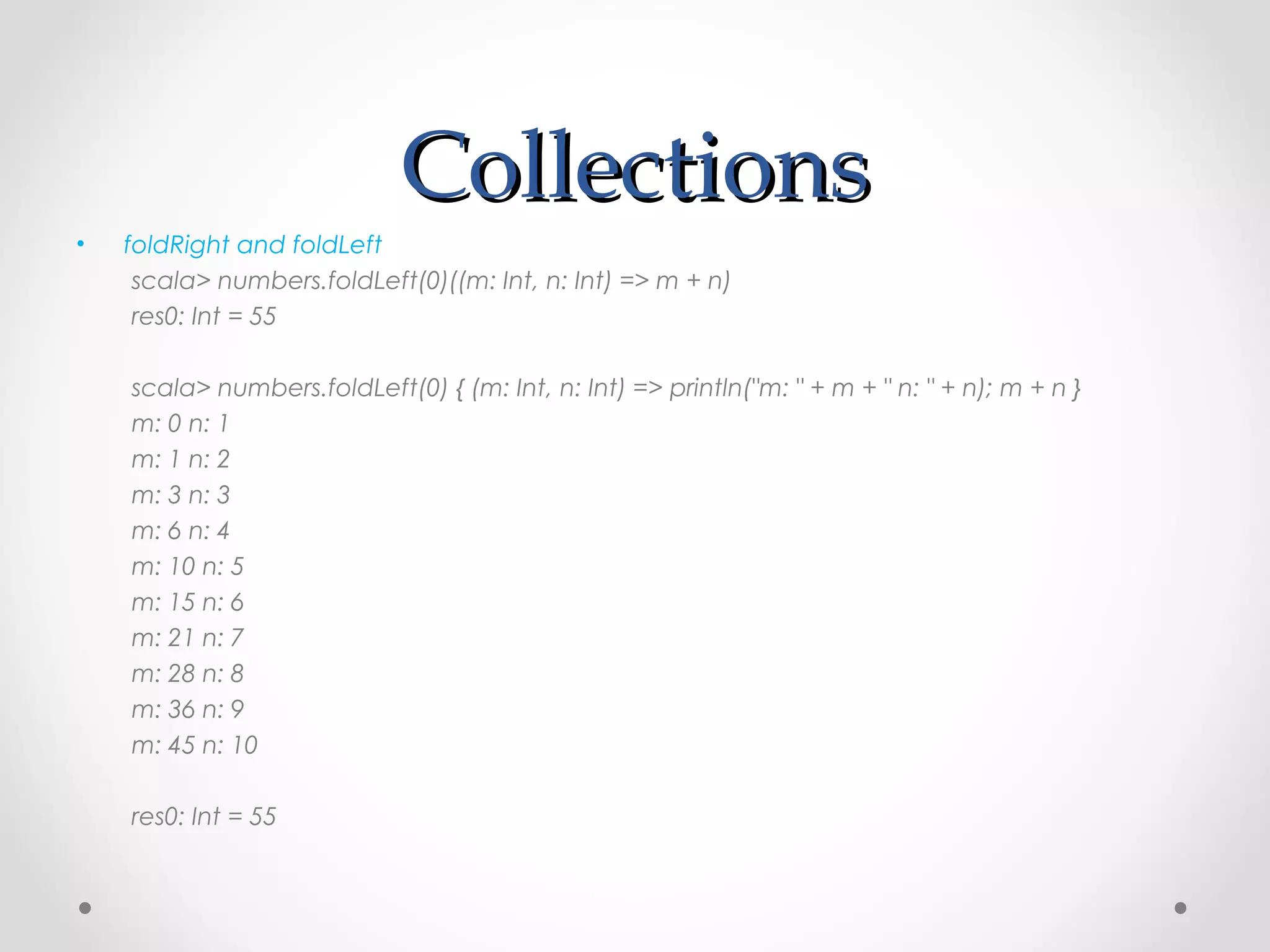
![Collections
• Flatten
scala> List(List(1, 2), List(3, 4)).flatten
res0: List[Int] = List(1, 2, 3, 4)
• flatMap
scala> val nestedNumbers = List(List(1, 2), List(3, 4))
nestedNumbers: List[List[Int]] = List(List(1, 2), List(3, 4))
scala> nestedNumbers.flatMap(x => x.map(_ * 2))
res0: List[Int] = List(2, 4, 6, 8)
• Generalized functional combinators
every functional combinator shown above can be written on top of fold.
def ourMap(numbers: List[Int], fn: Int => Int): List[Int] = { numbers.foldRight(List[Int]()) { (x:
Int, xs: List[Int]) => fn(x) :: xs } }
scala> ourMap(numbers, timesTwo(_)) res0: List[Int] = List(2, 4, 6, 8, 10, 12, 14, 16, 18, 20)](https://image.slidesharecdn.com/anintroductiontoscala-130411234814-phpapp02/75/An-introduction-to-scala-22-2048.jpg)
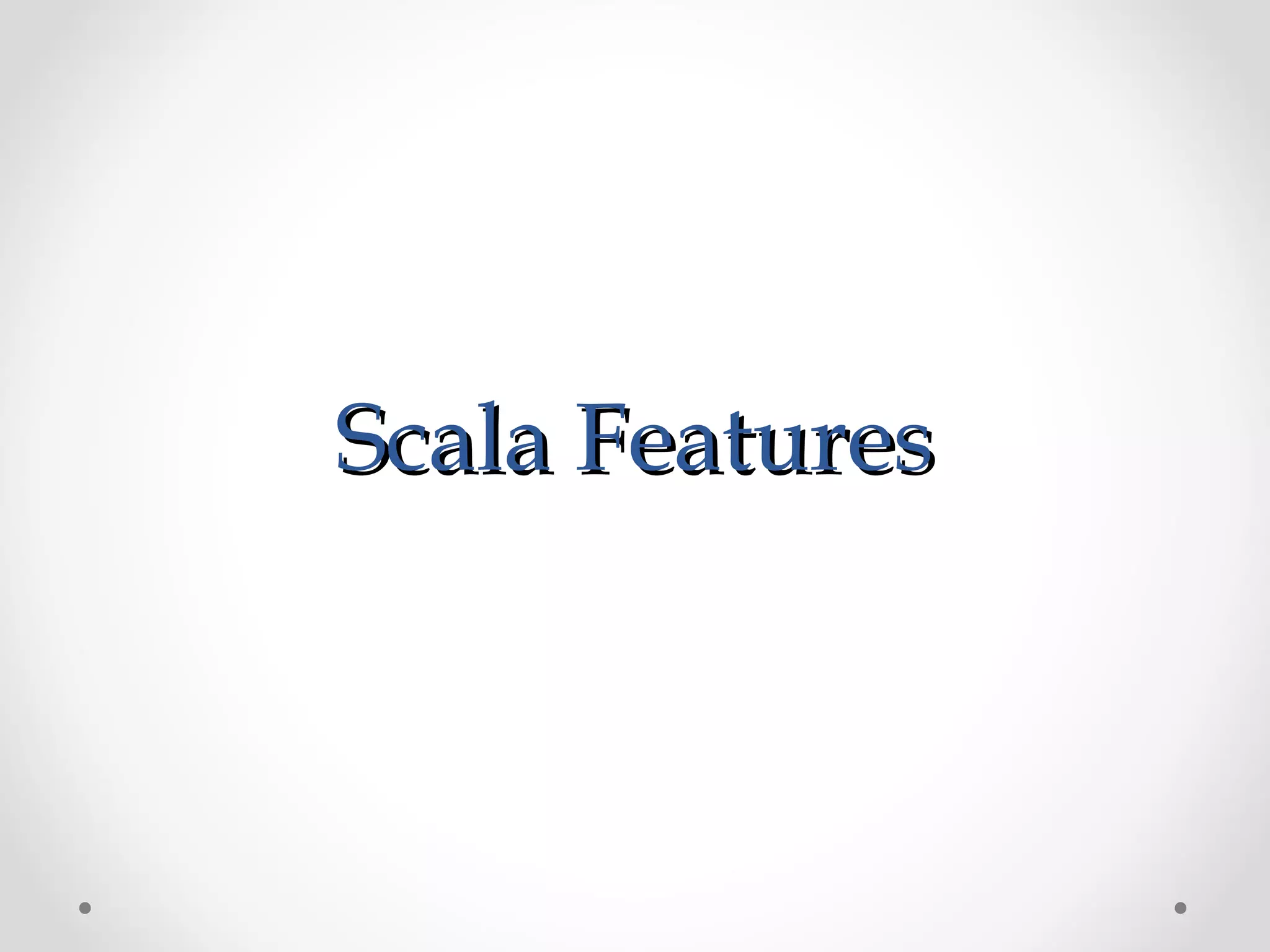
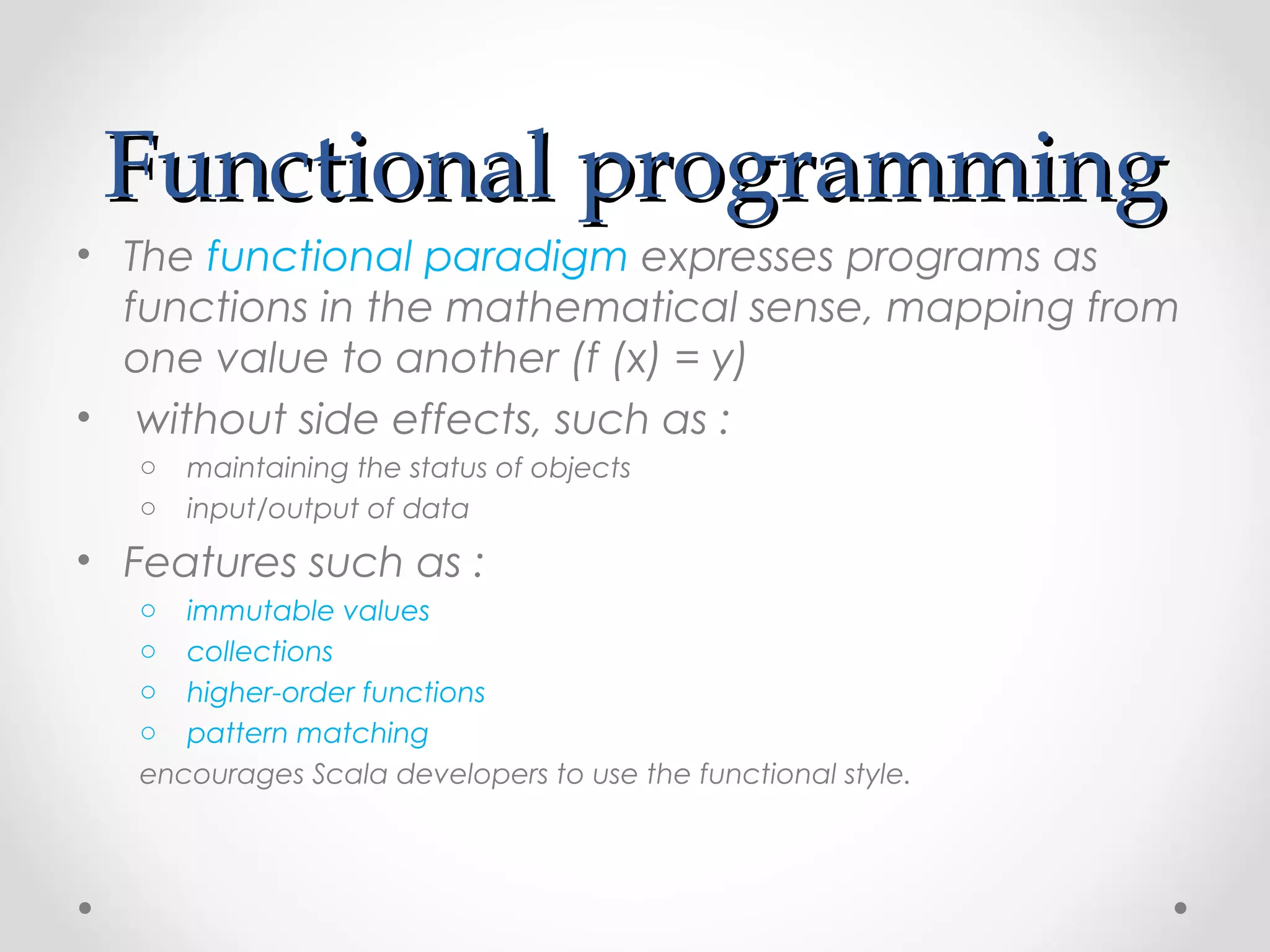
![a program that prints the thousandth element of the Fibonacci sequence can be written as
follows in Java:
import java.math.BigInteger;
public class FiboJava {
private static BigInteger fibo(int x) {
BigInteger a = BigInteger.ZERO;
BigInteger b = BigInteger.ONE;
BigInteger c = BigInteger.ZERO;
for (int i = 0; i < x; i++) {
c = a.add(b);
a = b;
b = c;
}
return a;
}
public static void main(String args[]) {
System.out.println(fibo(1000));
}
}](https://image.slidesharecdn.com/anintroductiontoscala-130411234814-phpapp02/75/An-introduction-to-scala-25-2048.jpg)
![a more compact and functional version, using infinite
sequences and tuples can be very different:
import scala.math.BigInt
object Main extends App {
val fibs: Stream[BigInt] =
BigInt(0) #:: BigInt(1) #:: fibs.zip(fibs.tail).map {
n => n._1 + n._2
}
fibs take 5 foreach println
}](https://image.slidesharecdn.com/anintroductiontoscala-130411234814-phpapp02/75/An-introduction-to-scala-26-2048.jpg)
:T = { val start = System.nanoTime() val result = func val elapsed =
System.nanoTime() - start println("The execution of this call took: %s ns".format(elapsed)) result }
def myCallback = { Thread.sleep(1000) "I just took a powernap" } val result = measure(myCallback);](https://image.slidesharecdn.com/anintroductiontoscala-130411234814-phpapp02/75/An-introduction-to-scala-27-2048.jpg)
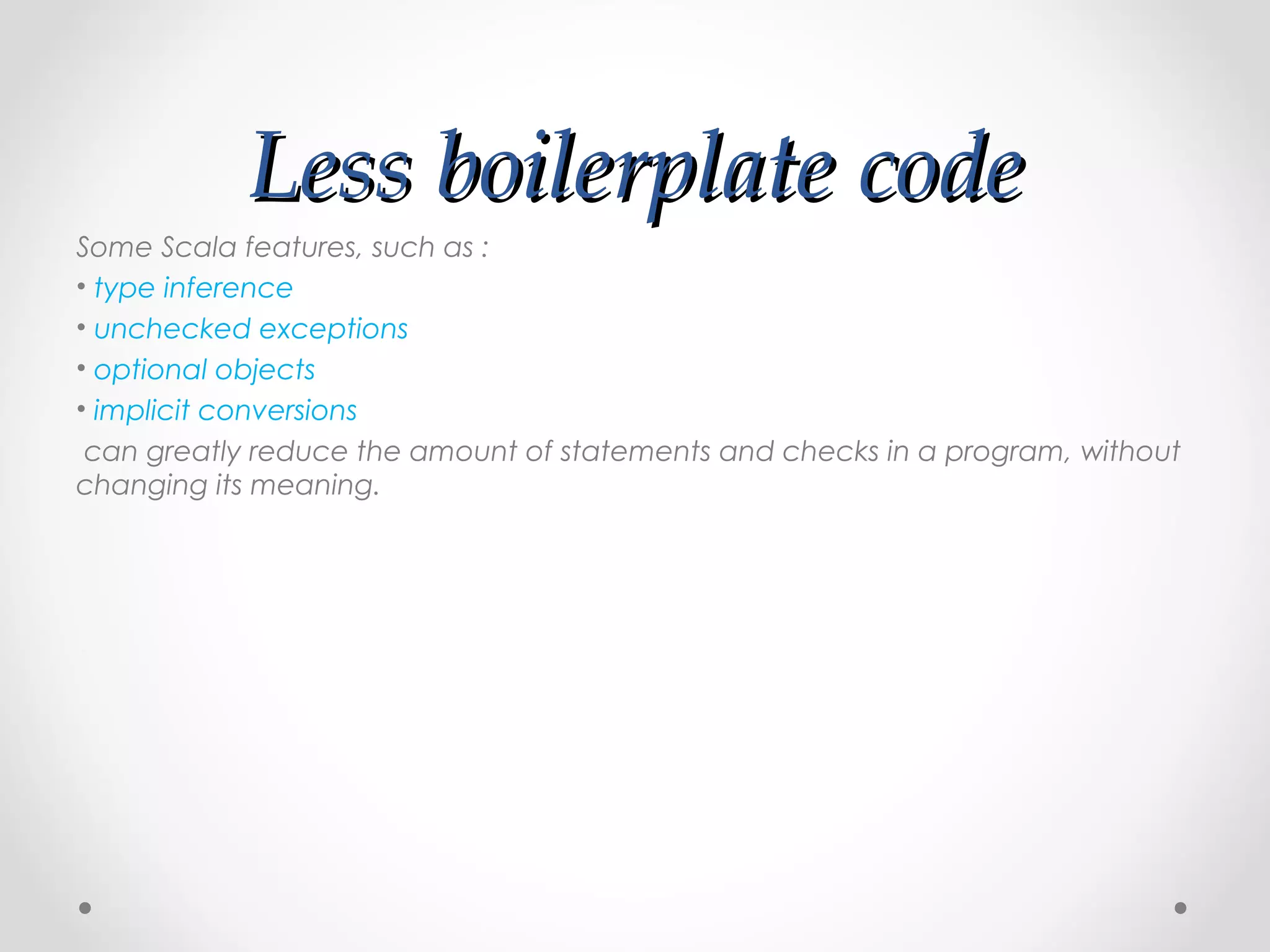
![In Java:
import java.net.NetworkInterface;
import java.net.SocketException;
import java.util.Collections;
import java.util.Enumeration;
public class ListMACsJava {
public static void main(String[] args) throws SocketException {
Enumeration<NetworkInterface> nics =
NetworkInterface.getNetworkInterfaces();
for (NetworkInterface nic : Collections.list(nics)) {
byte[] mac = nic.getHardwareAddress();
for (int i = 0; mac != null && i < mac.length; i++) {
System.out.format("%2x", mac[i]);
System.out.print(i == mac.length - 1 ? 'n' : ':');
}
}
}
}](https://image.slidesharecdn.com/anintroductiontoscala-130411234814-phpapp02/75/An-introduction-to-scala-29-2048.jpg)
![In Scala:
import java.net.NetworkInterface
import scala.collection.JavaConversions._
object ListMACsScala {
def main(args: Array[String]) {
NetworkInterface
.getNetworkInterfaces
.flatMap(nic => Option(nic.getHardwareAddress))
.map(_ map ("%02x" format _) mkString ":")
.foreach(println(_))
}
}](https://image.slidesharecdn.com/anintroductiontoscala-130411234814-phpapp02/75/An-introduction-to-scala-30-2048.jpg)
![Or, another implementation in Scala using sequence
comprehension :
import java.net.NetworkInterface
import scala.collection.JavaConversions._
object ListMACsScala {
def main(args: Array[String]) {
val nicaddresses = for {
nic <- NetworkInterface.getNetworkInterfaces
addrbytes <- Option(nic.getHardwareAddress)
} yield {
addrbytes map {
"%02x" format _
} mkString ":"
}
nicaddresses foreach println
}
}](https://image.slidesharecdn.com/anintroductiontoscala-130411234814-phpapp02/75/An-introduction-to-scala-31-2048.jpg)

